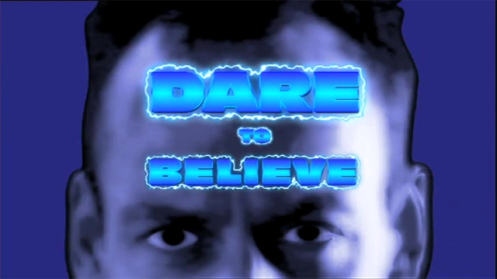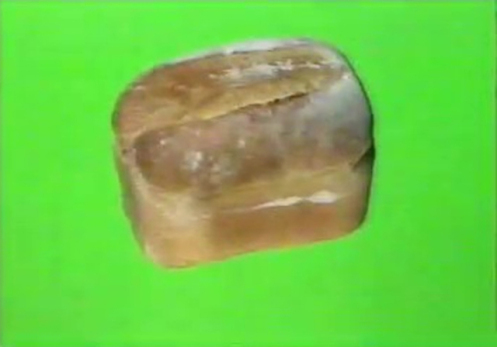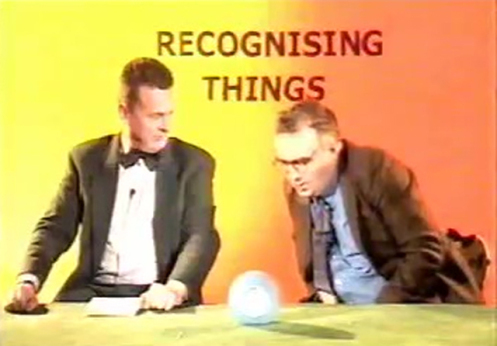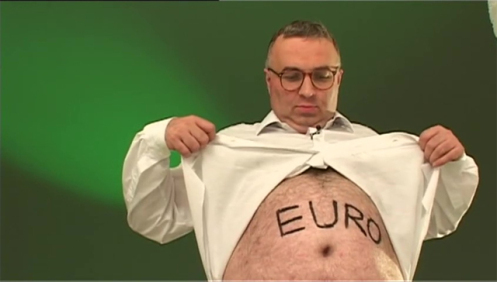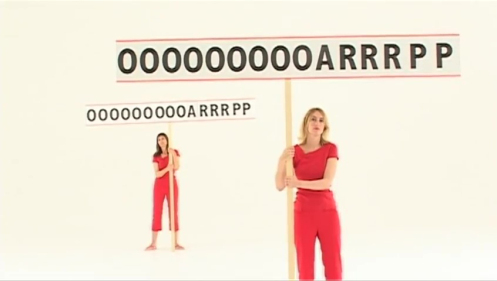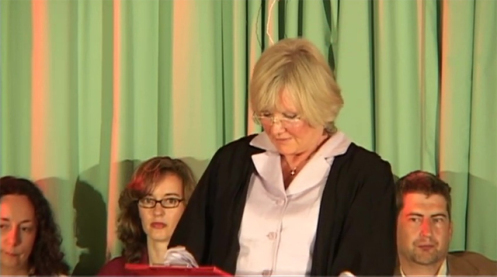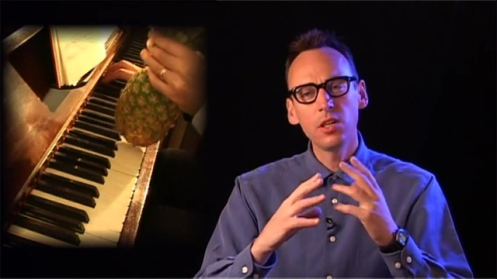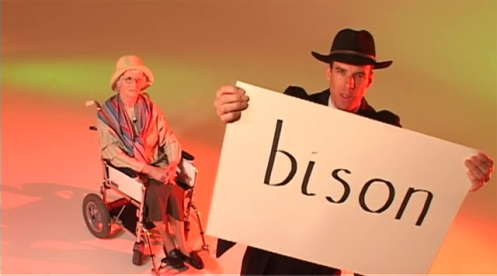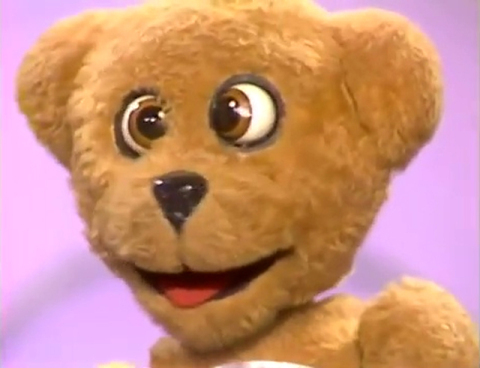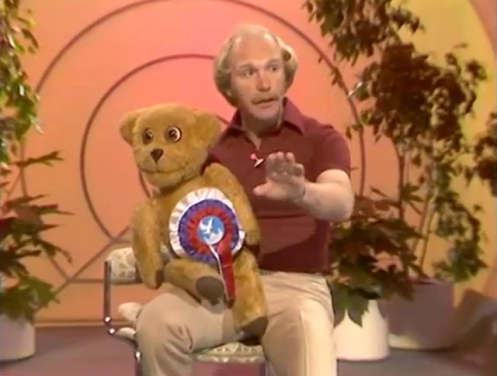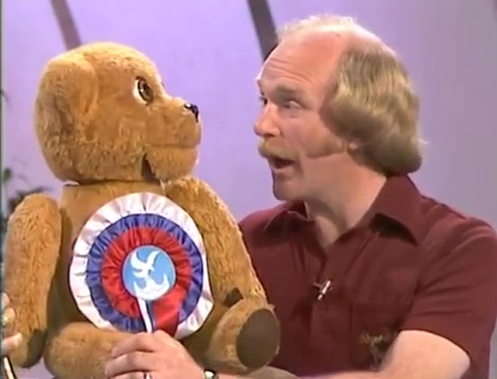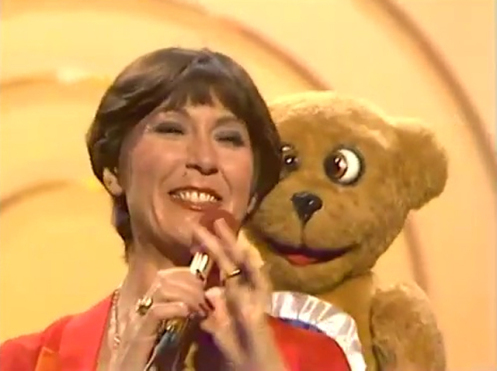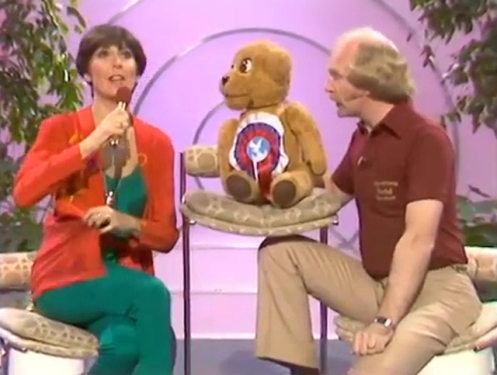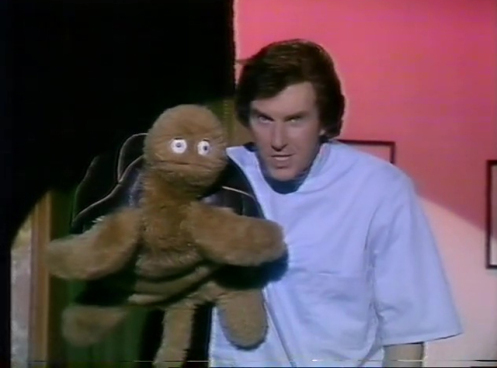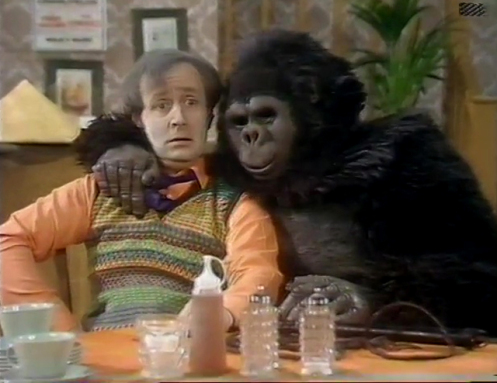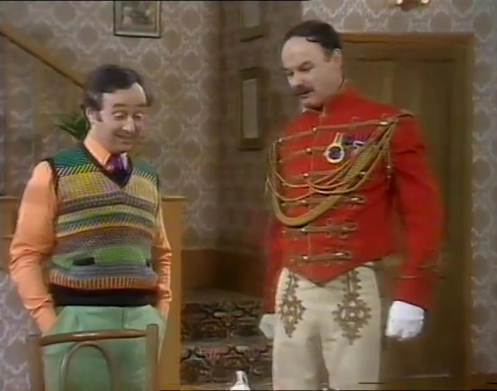Stuart Millard's Blog, page 15
June 27, 2021
Saturday Morning Archaeology: Saturday Superstore
A dense 23 mins, my latest video essay takes in frustrated rockstar Mike Read, the role of Saturday morning shows as analogue social media, and the wistful sight of David Icke laughing with friends.
…
This video first appeared on my Patreon, where subscribers could watch it a month before it landed here. If you’d like to support me for as little as $1 a month, then click here to help provide the world with regular deep dives about weird-bad pop culture, early access to my podcast, and all kinds of other stuff.
There’s over 500,000 words of content, including exclusives that’ll never appear here on the free blog, such as 1970’s British variety-set horror novella, Jangle, and my latest novel, Men of the Loch. Please give my existing books a look too, or if you’re so inclined, sling me a Ko-fi or some PayPal cash.
June 17, 2021
The Little and Large Show

[more Little and Large: Who Do You Do? — Double Dare — Stout and Reed]
Since I made it my business to cover the very worst in pop culture, I’ve built up a list of Holy Grails, which have so far been impossible to track down. Bobby Davro’s Rock with Laughter. Lynne Perrie’s softcore/comedy workout video. All 27-hours of each ITV Telethon. An early 2000’s Channel 5 show which gave celebrities prosthetic make-up, to help them experience life with a facial disfigurement; Caprice with a port wine birthmark and so on. Burn victim Craig Charles misunderstood the brief, leaping out at passers-by as a slavering horror movie creep. While some lost treasures, like Keith Chegwin’s Naked Jungle have eventually shown up online, others seem destined to rot, forgotten and un-Millarded, at the back of a nan’s attic. This was particularly true of my number one want, The Little and Large Show. With just a single Christmas special finding its way onto YouTube, 75 episodes remained unseen, of what legend tells is some of the worst comedy every created.
In lieu of the proper series, I had to satiate my appetite with their guest appearances on Double Dare and Who Do You Do?, which are linked at the top, and you may wish to read before continuing. Such was my obsession, I even penned a 27,000 word novella centring on a fictionalised version of their relationship, titled Stout and Reed, for the $5 tier of my Patreon. As a consequence, like my Charles Manson, imagined versions of Syd and Eddie have been living in my head for a while, and should the series ever surface, I knew I’d have to re-separate them again. And then it happened; The Little and Large Show suddenly appeared, and I dropped everything.
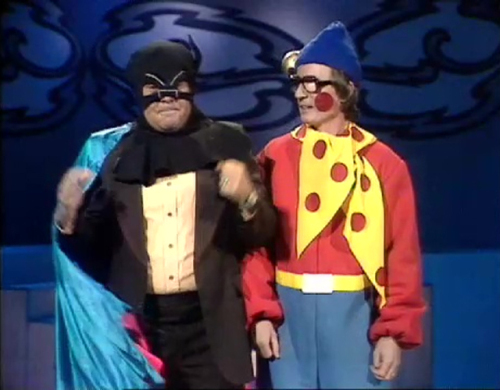
Eddie Large and ‘Supersonic’ Syd Little previously headlined their own show on ITV, with The Little and Large Telly Show running for a single series in 1977, before the pair transferred to the BBC the following year, as an intended replacement for Morecambe and Wise, who’d jumped the other way. In a golden age for double acts, none represented their stage names so cartoonishly as Little and Large. The big, round face of Eddie, topped by a sweaty mop of Kevin Keegan curls, and a pie-built body stuffed into a creaking suit, only helped emphasise the lankiness of Syd. With limbs like broom handles, and coke bottle glasses magnifying his gormless, blank expressions, they were a perfect comic pairing, who you could’ve identified from shadows alone.
Though they began at the BBC with a special, I’m starting at the beginning of the series proper, at episode one, originally airing on Saturday 30th September 1978 at 8:30pm, between All Creatures Great and Small and Starsky and Hutch. Animated titles show the lads waving through portholes of a UFO that’s circling the planet, before parachuting into the BBC. And then Eddie’s out by himself, welcoming us to the show before he’s joined by Syd, who’s dressed as a chicken. “Hello, my little chickadee,” says Eddie, “sssssufferin’ succotash!” All the choices I’ve made over the course of my life have brought me to this moment.
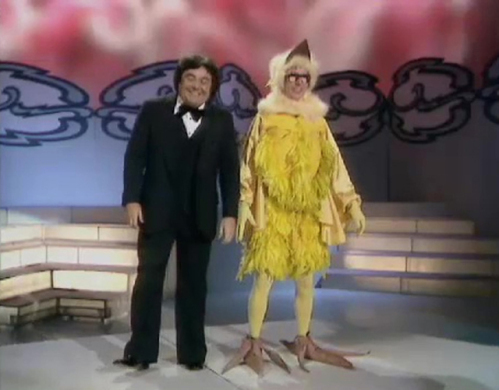
Like all the variety acts, Little and Large have a trademark bit. Perfected during their years in the working men’s clubs, it’s this routine which brought them to the dance, winning Opportunity Knocks and landing them their own series. You know the one; Syd tries to sing or tell a story, but Eddie keeps interrupting with impressions and gags. Also used by Cannon and Ball, this is the standard skit for the era’s double acts, and it’s on full display in the opener, which functions as a five-minute encapsulation of an entire career. A best and worst of, all at once. Eddie batters Syd with a relentless series of abysmal bird puns — the Incredible Hawk, Canary Grant, George Seagull — and impressions; voices which over the course of six episodes, we will hear many, many times. There are two jokes about boobs. Syd fucks up a line. Eddie walks offstage, quickly returning in a bird costume of his own, holding a giant wishbone and singing Brown Girl in the Ring. “Who’s that?” asks Syd. “Wish-Boney-M!” replies Eddie. This is Little and Large.
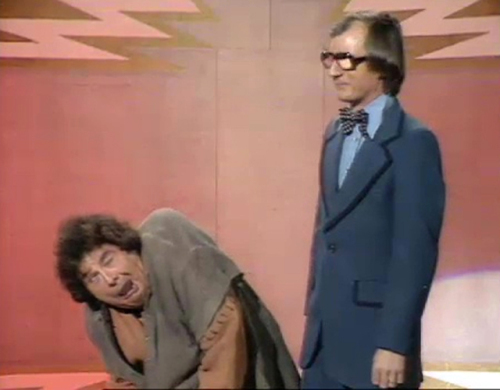
As becomes clear very quickly, this is not simply a routine of theirs; it’s the whole act. In another skit, mere five minutes later, Eddie (dressed as the Hunchback of Notre Dame) shouts over Syd with impersonations of Roland Rat, Les Dawson, and Kerry Packer, with a routine about the Emmannuelle films, solely to get to a line about “practising yoga, bare,” allowing him to go into a “hey-hey, Boo-Boo!” and a punchline about “the biggest boo-boos I’ve ever seen.” Three minutes after that, a segment titled Supersonic Sings Sinatra has Syd sat at a bar in a fedora, mic in hand, and getting a single line out, before Eddie pops into frame; bald wig, gigantic comedy sunglasses, and biting into a lollypop as Kojak. Then there’s ping-pong balls over the eyes — “ah, glasshoppah! Confucius, he say man with Chinese cat who keeps looking through ladies windows has Peking tom!”
The set-up of Syd stood or sat in front of something; a bar, wall or hedge; while Eddie pops up in different wigs, is their most frequent format, like old arcade games where every level’s the same, except this time it’s a sewer instead of a street. Here, we get Eddie’s Benny from Crossroads, his Jimmy Savile, and in a madcap run through characters after snatching the mic off Syd altogether, fifteen different celebrities. But it’s mostly worth it when Sooty pops up on his right hand, followed by Sweep on his left, and finally Soo, rising up in the middle as Eddie looks down aghast, his expression inferring “she’s on the end of me prick!”
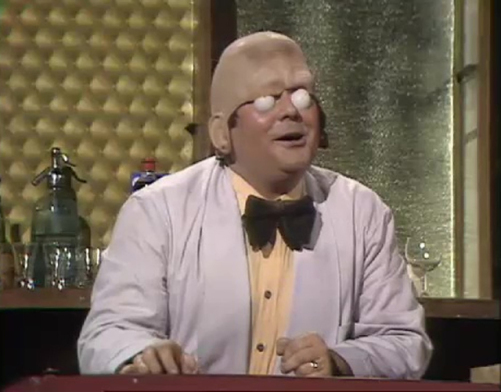
In a half-hour show, and with six minutes going to guest acts, Eddie does 59 different impressions (not including recurring voices), and on paper, you may be wowed by the sheer volume. But though Eddie Large would never have claimed to be a great mimic, let’s make something very clear; they are absolutely fucking dreadful. A large percentage begin “Hi, (name of celebrity) here!” and are so otherwise unrecognisable, you wonder if he’s only ever seen a photo. Who can’t do a guessable David Bellamy? Eddie Large, that’s who. Sometimes they’re just his own voice, as with a Larry Grayson which sounds like someone reading Larry’s quotes off a piece of paper, and play like those funny videos of fusty lawyers flatly reciting rap lyrics about pooing in a policeman’s mouth as evidence in a obscenity trial.
This unrelenting barrage of impersonations leaves room for merely a handful of proper sketches over the whole series. It’s all just a vehicle for Eddie to machine gun us to death with very similar voices, using an actual, literal box of wigs and funny glasses, always within reach, to dip into like a brutal mob torturer slowly caressing a glinting array of pliers and scalpels. Characters rarely last longer than a line, and as he flits between accents and hats, it feels as though you’re watching a man with 1,000 different personalities all fighting for control. Weirdly, the comparison which comes to mind with Eddie’s frenetic leaping about is Chris Farley, if he’d come up through the northern clubs. For Syd, I can’t choose between a mop or a brick wall.
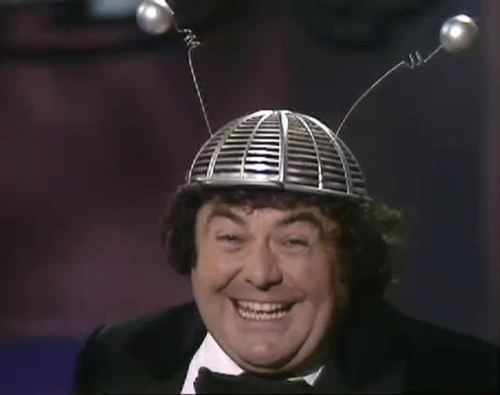
Eddie’s ramrodding is broken up by weekly guest artists, like the Four Tops, Charley Pride, and the Drifters, plus a regular spot for sexy dance troupe Geoffrey Richer’s Birds of a Feather (classic named-after-male-choreographer titling). In their debut routine, they’re dancing in and out of mock shower cubicles with horny plumbing innuendo like “shove more coal on the boiler” and “the radiator’s hissing, but still I need your kissing.” The absolutely demented lyrics really bear repeating, played between towel-clad showgirls with the “what do we want?!” rhythm of a protest march.
“Coal in the boiler?”
“No good!”
“Oil in the burner?”
“No good!”
“Is it coal?”
“No!”
“Hot?”
“Yes!”
“Yes it is! Come on people, get hot!”
What’s the allusion here? Boiler is obviously fanny, but oil and coal? Cum? A bollock? Talking of bollocks, banter aside, we have a filmed insert to fill time, where the lads lark about with members of the public. I say ‘the lads,’ but Syd’s just stood there. He doesn’t even have a mic. Eddie trades impressions with old men, children, and shirtless teens on the beach; civilians literally getting trusted to do more than Syd Little on his own show, with one lad doing a Rigsby and Norman Wisdom, and another bloke busting out proper gags as Groucho. A small boy’s Blue Peter joke — “today we’ll show you how to make a kite out of Angela Rippon’s knickers!” — gets a reaction Syd could only dream of. “I wish I was taller,” says Eddie, leering down a woman’s cleavage, and when a kid does his John Wayne, Syd’s not even in frame.
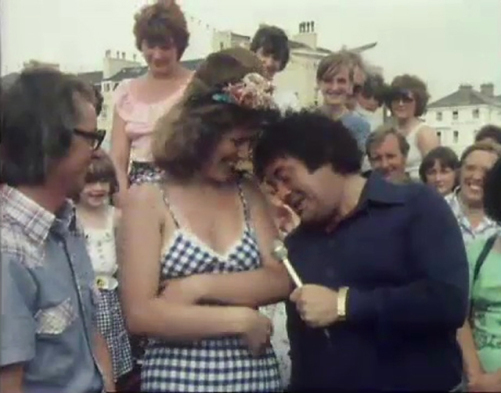
A lot’s been made of Syd Little’s legendary ineptness, especially by me, but in freebasing so much raw footage, one begins to feel oddly sympathetic for the author of autobiographies Little by Little and Little Goes a Long Way. Syd’s strength as a ‘performer’ is in knowing his role, which is to stand next to Eddie Large as he puts on a cowboy hat and says “I’m John Wayne.” Though there’s a loose, pissing-about feel, it’s Syd who blows his lines most frequently, relying on Eddie to improvise things back on track. At one point, Eddie teases him for coming in too early — “you nearly killed my laugh then!” — and later, Syd bumbles a line with “I was fed up with being thinny and skin...” “Thinny and skin?!” gasps Eddie, as the audience erupts, before a sudden and obvious edit.
For the first episode’s closer, Syd’s interrupted by Eddie in a mumu and false beard as Demis Roussos. And then as Rolf. And American TV detective Cannon. While the voices aren’t good, at least there’s jokes, like Eddie saying Syd knows nothing about telly — “he thinks Pot Black’s a cooking show about cannibals!” Eddie reckons Farrah Fawcett should present The Sky at Night, “because she’s a heavenly body,” as ‘Patrick Moore’ tells us when she loses all her teeth, she’ll be known as “Farrah False-set Majors!” This kind of agonised, arms length reaching to a punchline is typical of L&L’s material. In episode six, Syd accuses Eddie of being unromantic — “you haven’t got a heart!” Eddie tells him nobody has, as from tomorrow, the Trade Descriptions Act is legally changing the word ‘heart’ to ‘pump’. It’s just the pathway to more impressions, like Tony Bennett (“I left my pump in San Francisco…”) and Elton John (“don’t go breaking my pump!”).
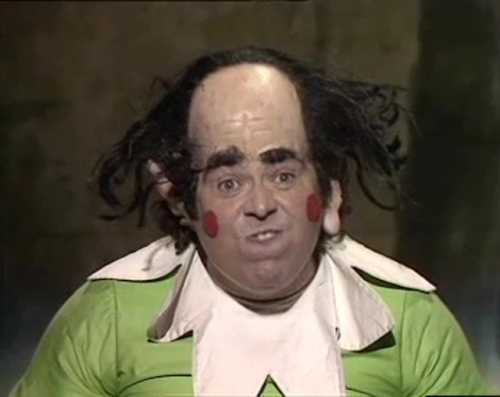
Episode one ends with Eddie rifling through the dressing up box for a gauntlet of Wonder Woman, the Man from Atlantis, Karl Malden — “hi, I’m Karl Malden from The Streets of San Francisco” — the Smash Aliens, Rigsby, and for the second time tonight, Kermit and Humphrey Bogart. Perhaps the highlight is a non sequitur of chanting “Supersonic is a moron!” as himself, before they close with a ‘duet’ of Gimme Dat Thing, with Eddie trying to steal the mic.
There’s no sense in these early shows, as there is with the later appearances which inspired Stout and Reed, that Eddie might’ve been putting the boots to Syd backstage for how useless he was, and weirdly, Eddie isn’t even that large here. He’s tubby at best, incredibly energetic with it, and visually shorter than Syd, who doesn’t seem as thin as the Syd Little of legend, in comparison to a smaller Eddie. An odd foible is how they always stand with Eddie on Syd’s right, breaking the Ant and Dec rule of a double act’s onscreen positions giving a correct ‘reading’ of their names, and rendering them visually as Large and Little.
Episode two opens with Eddie in an incredible red velvet suit and Syd dressed all Shakespearean, armed with Yorick and ready to perform a soliloquy. Would you believe it, Eddie keeps butting in? He’s putting a fez on the skull to do Tommy Cooper, then Eric Morecambe, Cliff Richard III and Miss Piggy, where the mask doesn’t fit over his head, and sits halfway up his face as he sings Hey Pig Spender; then Kojack again, Henry Cooper, Les Dawson. Sid just stands there. Soon, Syd’s got a bow in his hair, singing The Good Ship Lollypop, which he grossly pronounces “wowwypop,” and you’re praying for Eddie to come out. But then he does, and you’re praying for death instead.
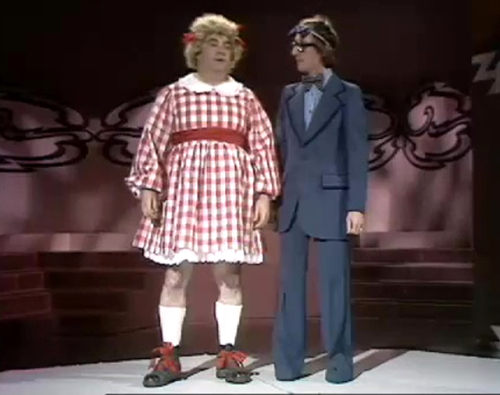
Most of the show’s surprisingly risqué — or rather, crude — for something pre-watershed, with so many of Eddie’s jokes focussing on great big wobbly jugs, and making constant sexual references to famous women. His Benny from Crossroads shows up at least once a week to brag about nobbing Miss Diane, and it’s all the exact kind of stuff we’d have done in the playground as kids. I can vividly picture me and my chums playing Ghostbusters while some third year in an unwashed parka corners us to perform Eddie’s Buddy Holly song about Robin Hood before scuttling off — “Maid Marian said, she’s sat sobbin’, nine months gone and no sign of Robin, oh boy!” You half expect him to ask Syd if he’s ever touched a BMW, before dead-legging him into eating a urinal cake. “Have you got AIDS, Syd? Are you positive?”
Though David Renwick and Eddie Braben get listed as writers (presumably with Satan going uncredited), it’s a shocker not to see the boy from your class who kept turning his eyelids inside out on there too. Truly, the Little and Large Show contains some of the smelliest, low-grade jokes ever spoken out loud; not worthy of the bin at the Christmas cracker factory, let alone television. Regard, a bit where Eddie’s dressed as a pirate, hopping on using a crutch, which is under the wrong arm because “I’m an Irish pirate!” and with a parrot on his shoulder called Starsky — “Starsky and Crutch!” He’s also pulling a plank of wood on a dog lead. You figure it out. I kept a running list of the very worst gags, and I think I’ve settled on a pretty sturdy top/bottom five.
Eddie, on Syd getting his acting skills from the Old Vic: “I told him to use a new jar!”Eddie with an Australian accent: “What do they call a happy dog in Wogga Wogga? A wagger-wagger!”Eddie: “Tell ’em about that film you were in, about that very tall Welshman; The Longest Dai…”Eddie as Cliff Richard: “I’ve just invented a new version of the rumba with my hairdresser, it’s called the rum-barber!”Eddie as Brian Clough as a Red Indian: “What’s the closest thing to silver? The Lone Ranger’s botty!”
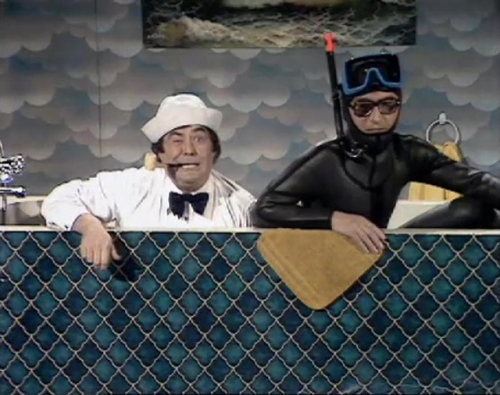
This is a good time to inform you the show had fifteen million viewers at its peak. There’s little respite, even when stepping outside the banter for rare sketches. These are generally quickies, like Syd calling a depression hotline and the phone box exploding, or walking to the Mastermind chair under its ponderous theme, only for Eddie to wrap a hairdressing cape over him. The most avant-garde moment of the series sees Syd as a policeman and Eddie crawling around on the floor as a lost dog, begging for scraps — “I’m a little lost doggie and I’m starving!” But he actually is a dog, and Syd hears his dialogue as barks. Though it seems like the most obvious thing they could do, there’s just one Stan and Ollie skit, where Syd’s performance, even for him, is really something. Perhaps he’s feeling vulnerable, left blind without his glasses, at the mercy of Eddie Large, and spends it fiddling with a bow-tie while Eddie does most of the talking, nervously getting his few lines out noticeably quietly. It’s a weird routine based around a magic cabinet, building to a parody of The Fly, where Syd/Stan gets a mouse’s head and Eddie/Ollie a mouse body; and all just an unbelievably convoluted contrivance for the obviously-thought-up-first punchline “that’s another fine mouse you got me into!”

Occasionally, we even break from the studio for outdoor sketches shot on film, which feels like being afforded yard time when you’ve been sat on death row. Crossroads Street features Eddie as various soap characters, and gifts us the brilliant visual of him sat in a wheelchair and whipping Syd, who’s pulling him like a horse, before Syd gets stabbed to death by Benny from Crossroads. In another, Supersonic’s walking through the street singing My Way, and getting abused by various bystanding Eddies; cutting through his mic wire, nicking the replacement mic (as Kojak) after mistaking it for a lollypop, popping a champagne cork into Syd’s mouth, and leaving him in rags by the end, after being blown up, with Eddie standing triumphantly on his sobbing, battered body. Maybe there’s something to this bullying theory after all.
But mostly it’s all just the exact same thing, over and over again. Syd in an art gallery, Eddie doing celebrities as paintings (Larry Grayson, “what a Goya day!”). Syd in a pith hat at the zoo, Eddie doing celebrities as animals (Kojak panda, Frank Spencer chimp). Syd in a bath, Eddie doing celebrities as fish (rubber octopus in a bald wig, “who loves ya, octopussy cat?”). Syd as a fairy sat on a mushroom, Eddie doing celebrities as dwarves. I’m 4 episodes into a run of 77. At this point, I’ve perhaps gotten too complacent. Yeah, yeah, Syd’s addressing the lay jeh-men. Eddie will come out in a costume. I get it. I’m blogging’s bad boy, and I know everything! And I’m right; he does.
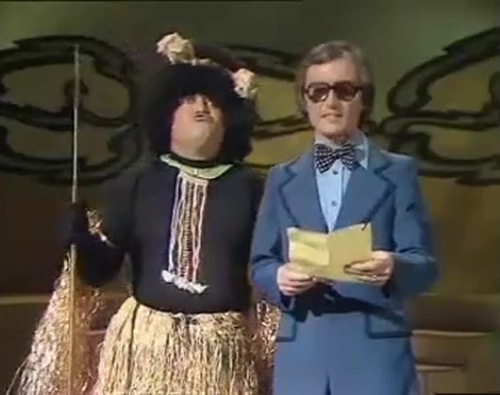
Blacked up everywhere but the face, Eddie’s gone full comedy Zulu; armed with a spear and squeezed into a black body stocking; grass skirt, bone through the hair, and patting his stomach while singing “oh black belly, bam-a-lam!” There’s an envelope spiked on the tip of the spear. “It’s blackmail,” says Eddie, belting out King of the Swingers, but with amended lyrics of “I’ve got lots of big black spots, we’ve run out of TCP!” He reels off a list of jungle food — “boiled beef and parrots, snake and kidney pie” — however the natives; “all they eat is insects, WHAT HAVE WE GOT ON DE MENU TODEY?!” With a final joke about Tarzan slapping one of Jane’s titties flat, he mimes a tribal dance round a fire, chanting the name Showaddywaddy by way of introducing them.
Presumably when the budget allows, they venture into visual gags which are just as CBBC as the one-liners, with Eddie climbing up a ladder to an eight-foot tall can of fly spray, to render the audience unconscious, and a bit where he’s holding a dog lead that stretches offstage and about twenty feet into the air. “What’d you call it?” “Sir.” “Where does it sleep?” “Anywhere it likes.” Eventually, it drags the pair across the studio floor, with Syd’s legs kicking wildly all the way. Reader, I did laugh, and I won’t pretend I don’t occasionally get blindsided by a funny line or surprising reveal. One sketch with Eddie as mayor conducting the Young Musicians of the Year pans to a load of prams with tubas and trumpets poking out, and in a grand finale with duelling guitars, Eddie’s is on an elastic strap, which is a genuinely hilarious visual. My favourite joke of the series involves Syd being interrupted by Eddie’s Columbo.
Eddie: “By the way, my wife thinks you’re terrific!”
Syd: “Oh, is she a fan?”
Eddie: “No, she’s stupid.”
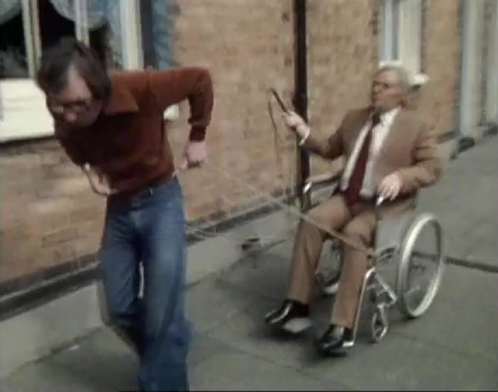
When I’m watching stuff for these pieces, the general rule is that footage takes four or five times as long to get through while taking notes, with all the rewinding and transcribing and whatnot. Consequently, there might only be three hours of this, but I’ve been marathoning it all day, leaving me near delirium by episode six, with moments coming at me like trucks, barrelling into my exhausted body as I stagger across the motorway; Eddie at the wheel and Syd locked in the boot. Eddie as a pirate, singing “fifteen men on Cyril Smith’s chest, twelve down his shirt and three up his vest!” Eddie as Norman Wisdom and Emu; “Mr. Grimsdale! Stop it, Emu!” Eddie singing a frenetic Shake, Rattle and Roll, and telling Syd it was written “the day after the girls burned their bras.” Needing two guitars for the big finish, Eddie calling off-frame, “Hey, the Fonz wants a guitar! Hey, sit on it Cunningham!”
Eddie’s Elton John. He’s Bobby Ball. He’s Liberace, making a joke about Raquel Welch’s massive knockers. Syd’s about to sing, but Eddie’s butting in as Rigsby; he’s rooting around in the hat box. Now he’s Benny. Top Cat. Norman Wisdom. It’s terrible and depressing, and unbelievably repetitive. And yet. Even with the rancid material, it’s hard not to get swept up in how much fun they’re having. Eddie’s face lights up on every punchline, his chubby cheeks curling up into his ears, eyes flitting about the studio to catch everyone’s reactions, and like Cannon and Ball, they’re battling through corpses all the way.
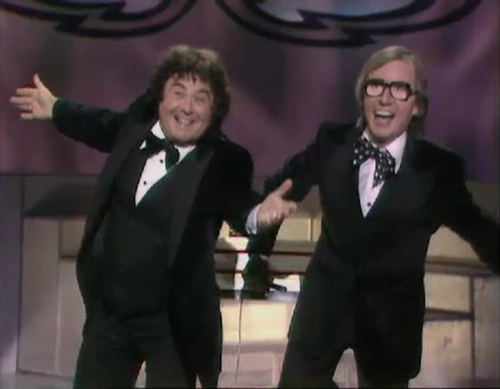
Though I wouldn’t recommend sitting through this in big doses (or even at all), the whole teetering structure is almost propped up by its endearing naffness, and though you definitely won’t be laughing, there is a certain joy by osmosis to be had. I don’t know if this sense of fun held up over the years, with the show incredibly having spanned three decades, lasting from 1978 to 1991. Against all good judgement, I’m really curious to what that final series looked like, being that the format wore itself out before episode one was over. After years of citing The Little and Large Show as one of my televisual Holy Grails, and now languishing in the post-Eddie exhaustion of having experienced it, two things have become clear. The first is to be careful what you wish for, followed by the terrible feeling that I’m far from finished with the lads.
…
This piece first appeared on my Patreon, where subscribers could read it a month before it landed here. If you’d like to support me for as little as £1 a month, then click here to help provide the world with regular deep dives about weird-bad pop culture, early access to my podcast, and all kinds of other stuff.
There’s a ton of content, including exclusives that’ll never appear here on the free blog, such as 1970’s British variety-set horror novella, Jangle, and my latest novel, Men of the Loch. Please give my existing books a look too, or if you’re so inclined, sling me a Ko-fi or some PayPal cash.
June 8, 2021
Dare to Believe
Though this series is more recent than the usual stuff on here, it crops up from time to time, as a query from those still awake after 1am with the telly on at the start of the millennium, existing as fleeting, half-remembered fragments, which linger like a buried trauma. Images of flowers and trees; a repeated assertion to “be the small bookcase” — was this a TV show, or a hallucination from when I was trapped in a neighbour’s shed, staving off thirst with a tin of creosote? If Dare to Believe was even real, what was it? Someone needed to finally try and pin that down, but as it turns out, that’s not easy, even when you’re literally watching it.
To place this in a cultural time, if we measure things in eras of ‘banter’ — with the current period being ironic memes and inferring anyone with bad opinions is a paedo — 2002-2004 was the era of being well-random. The Mighty Boosh were in their ascent, and lads on trains were putting Dairylea triangles on their heads because “oh my God, what am I like?!” To get a laugh back then, one simply needed to drop the name of an animal — “Weasel! Gibbon!” — and everyone kept mentioning badgers, all the time. As these mad lads roamed the earth, wondering aloud how many otters they could fit inside a silken handbag, ITV begun broadcasting the first series of a late-night sketch show entitled Dare to Believe.
It’s always best to start at the beginning, although the only existing copy of episode one is the worst quality rip I’ve seen since the days of RealPlayer, with the footage consisting of about three pixels. We open on an ominous black screen, and words in a white text reading “Seek only truth,” followed by the punchline “but in doing so, avoid the A47.” Treasure this terrible gag; ration the laughs carefully; as it’s the last actual joke you’ll be seeing for a very, very long time. The credits are rock-bottom basic, with silhouettes over primary colours, ending on a man’s forehead tattooed with the legend DARE TO BELIEVE. The opening sketch is another black screen, bearing the following words, spoken with the wise and hushed poise of a Zen master.
Fly like a mouse
Run like a cushion
Be the small bookcase
“Dare to believe…” whispers a voice. “Fly like a mouse” is the central motif, repeated throughout each show numerous times, like the Hare Krishna mantra, often over water-ripple reflections on coloured backgrounds, for 40 seconds at a time; sometimes cutting over the top of other sketches. Dare to Believe‘s disjointed nature makes it hard to analyse in the traditional way of looking at comedy, and all we can do is to stand well back, to examine the sketches with the clinical detachment of a bi-monthly phimosis check-up.
A man in a karate gi punches and kicks in an empty white space, with each battle cry transcribed in text alongside; PIKE. COD. CARP. BARBEL. A picture of a loaf of bread, with a female voice asking “what’s this?” A male voice responds “bread.” After five times, the man’s answer then changes, to “ENORMOUS COYPU!” This format will be repeated too, with varying objects; a nail, a lemon, “OSPREY HOUSING!” In another skit, two men sit at a desk, playing the game Recognising Things, with one laying out household items for the other to identify. “Is it a clock, Gavin?” Yes it is. Clock. Stapler. Saucepan. Iron. There’s no subtext here. It’s just a man dryly stating that a hairbrush is a hairbrush.
The entire series has a lower budget than a single TikTok video, with many segments consisting of still pictures with a voiceover, and almost every skit is a single person stood in front of a blank wall. If it’s meant to be a location (restaurant, library, concert hall), shots are kept in tight medium to show as little of the background as possible, presumably to stop a kitchen door or living room radiator leaning into frame. Most notably, the camera never moves; clearly always on a tripod or propped up on a table, after the performer’s pressed record before stepping in front of it. In a first for me, this is a show with literally no camerawork; no pans, no zooms, no cuts to a second angle; everything filmed like a mass shooter down in the basement, making a tape for the police to find after they’ve kicked the doors in.
Many sketches consist of a single line — a vicar saying “actually, there are 20 or 30 ways of skinning a cat” — or a single image; silent footage of flowers and trees; two trumpeters stood up to their waists in a swimming pool. One’s just a close-up of hands completing a Rubix Cube. In another, a narrator informs us “this is a coconut” over a picture of one. There are inserts of objects (book, tennis racquet), with onscreen text denoting what their words are in Czech. In a sketch so funny, it’s done multiple times, a man sticks a pointy sign for sandwiches in the ground before running off, as a voiceover says the word “sandwiches.” I can’t imagine how many train carriages were filled with guffawing re-enactments on the way back from college.
Others bits have the precise energy of when your mate realises you’re filming them and shows off by saying something silly; like a bloke crouched next to a green spiky plant telling us in an Attenborough voice “it’s a green spiky plant.” There are a couple of more traditional set-ups, like a brief coffee ad parody, but at every turn, the thing they’re Daring to Believe is that simply doing or saying a random thing is enough. A businessman pretends a hole punch is biting a laptop. A Spanish chap dubbed in English witters on about “the agua moose.” Why waste time writing material when you could just do Madlibs mashing of unconnected nouns? A French waiter informs us today’s special is “a basket of swan jackets,” punching the air with an excited “yes!” Later, this is replicated, but with “a jar of photocopied haberdashery.”
Signs frequently come into use, with footage of blackboards in public places, scrawled with stuff like “SORRY, THIS BUILDING IS WRONG, PLEASE LOOK THE OTHER WAY.” On paper, it sounds like an attempt at Trigger Happy TV street-pranking, but they chose not to use any film where passers-by were actually looking at or reacting to them. There are also road signs, in the form of clipart pictures, occasionally altered with comic bon mots like EXCLAMATION MARK AHEAD. Extremely low resolution and poorly cut, they’re like something a well-meaning, chuckling teacher puts on the overhead projector, during the last lesson of summer term. Is this bad aesthetic a conscious artistic decision, or just cheap and lazy? The show constantly forces its audience to ask these questions of it, number one being, is this subversive, dada-ist weirdness, or unbelievably awful rag week shit?
If they can be said to be trying at all, with the minimalist dialogue and sleepy visuals, they’re clearly going for the dreamy, hypnotic sense of a self-help video, but the arbitrary and simplistic nature brings more to mind the videos you can stick on a tablet for your cat to look at when you’ve gone to work. For all the adult stimulation one gets from Dare to Believe, you might as well hang it above a baby’s crib. Everything’s so inhuman, with the rhythm of adults performing nonsensical jokes written by five year olds; a script by AI. Was this generated using the algorithm behind all those YouTube accounts for toddlers, where Spider-Man gives birth to Elsa from Frozen? It’s so glaringly, overwhelmingly wretched that it seems like a test. If I laugh, will a team of psychologists run into the room, congratulating each other for proving that if anything’s presented as a comedy, some idiot will laugh at it? Or if I hate it, will I be denounced as an artless oaf who deserves nothing better than Mrs Brown’s Boys? The boorish man at the Tate Modern, shaking his head because “it’s just a bleedin’ unmade bed; load of rubbish!” But of all the things Dare to Believe could be interpreted as, the one thing it never comes close to being is funny.
I jump forwards to an episode from the second series, which is much better (visual) quality, as it’s taken from an inexplicable DVD release, which featured just 3 episodes, all from the second series. As before, it opens with “fly like a mouse,” but immediately raises the stakes, with the added gravitas of bringing Patrick Allen into the cast, to deliver their voiceovers of absolute bollocks. It’s important to note that between the first episode and this one sat at least 12 more, showcasing top-drawer laziness by continuing to reuse huge amounts of material from that initial half hour. They’ve taken the Little Britain model of weekly catchphrases a step further, by changing nothing but the nouns. “What’s this?” is back, along with the agua moose, the sandwiches sign, karate man, and office man making brum-brum noises while pushing a lamp across the desk. By my reckoning, roughly 10% of its 23 minute runtime is chewed up by the whispered “dare to believe” over a yellow background. Another 10% for agua moose. 5% for “What’s this?” 10% for Recognising Things. Stick some footage of road signs in and you’ve basically hit the credits. Some cash please, ITV!
Series two is marginally more conventional, in that they’ve been given slightly more money for old rope, allowing for outdoor shoots (gardens instead of kitchens), and for more than one person to appear onscreen at once. There are new recurring characters; a roving news reporter who collapses before he speaks; a football coach who tells his players “try being better at playing football.” There’s even a skit with a headmistress presenting an assembly, and warning of punishment in the badger pit (it’s no Ripping Yarns), where four teachers are sat behind her. After the first series, this sudden population explosion feels like fucking Gandhi, and it’s here we’re treated — for the first time — to an exhilarating second camera angle! The framing here is genuinely astonishing.
“Shall we get that woman’s whole head in?”
“Nah, it’s fine”
“Do you not want to pan down a bit, so we’re not cutting people off at the chin? Also, the middle one’s looking into the lens, we should prob–”
“ACTION!”
If you got your wedding video back looking like that, you’d be in the local paper doing a face. The most sketch-like sketch yet — DIY with David I. Young — even has its own theme song, as he builds… oh, a badger hod for carrying badgers, with a “detachable goose tidy!” Yes, I remember being at school and seeing Vic and Bob for the first time too. Haha, badgers and otters and cheese! The same actor does a bit about mending the boiler where he’s clearly just put the camera they were all given onto his own kitchen counter. Another character wanders across sand dunes with a surfboard saying he’s “stoked” in a bad Australian accent, like a 12th rate Paul Whitehouse doing his “brilliant!” while the boom mic’s visible in the corner.
But the inescapable spectre of randomness haunts the show. A child hangs bicycle parts off a man dressed as a scarecrow; a man in a nappy stands ankle-deep in a river; a man pretends his hand is a duck’s beak; people disappear in puffs of smoke when found to have no otters during the “otter count.” At the point someone starts playing a piano with a pineapple, while I’m in the middle of another 70-hour working week trying to grow my Patreon, I become very angry at the knowledge people were given airtime and paid money for this. I’ve accused shows of being low/no effort before, but all the terrible things I’ve covered have at least had some ideas in them. Even the most half-arsed shite still began with someone sitting down to write a script, and didn’t just say the word bread over a picture of some bread. If your teenage nephew banged out these sketches on his phone, they’d have a single figure viewcount, and he’d get a well-deserved cyberbullying. ITV let this happen 26 times.
The notion that this is surrealist performance art and not just people who are very shit at comedy is disproved when they try actual gags, like a sportscaster whose co-host won’t speak; “ah come on, Joe, I bet they got the test results wrong…” Or when a cyclist is given a jar of pills and professes “I don’t believe in drugs” before honking on a foot-long spliff. This is by far the least comic aptitude I’ve ever seen in anything, and I’ve sat through fucking Big Top. I’ve a strong and formative memory of being about 14 and answering the register in a silly voice, and the girl I most fancied in the world saying in a withering stage whisper to her mate “he thinks he’s funny.” The cast of Dare to Believe; they think they’re funny.
The DVD quality of series 2 reveals the guilty parties in the credits. Along with additional material from the performers, Dare to Believe‘s entire run was written and directed by one man. The Devil? Your divorced neighbour, who showed you a “wicked” Harlem Shake video just last week? No, a man called Tim de Jongh, who also appeared in the show, with the cast seeming to be a mix of bit-part actors and his theatre mates from uni. Also among them is wine writer Susie Barrie, novelist Michael Marshall Smith, and as a weird outlier, Amanda Abbington, who’s been in proper telly. Perhaps the most damning credit is reserved for Chris England and Paul Simpkin, which reads “performed their own characters.” Yeah, make sure you get credited for those memorable inventions; right up there with Partridge and Ron Bergandy. Which ones were they; the bloke pushing a stapler round a desk while making motorbike noises? The man in a hat holding up a sign with bison on it before an old lady in a wheelchair shouted BANG?
When I say the next episode in series two is more of the same, I mean it is literally exactly the same. More bicycle parts on a scarecrow. More sandwich signs. More agua moose. More Recognising Things. More “what’s this?” but without even the subversion of eventually yelling “STOAT!” and straight-up just stating that something is a knife or hammer or cucumber, over and over again. More badger hods, but with additional “weasel storage.” More “be better at football,” but with an extra variation, telling an offscreen chef to “be better” at presenting the garnish on his sandwich, which the actor clearly thought of while eating a sandwich in his own back garden, hurriedly resting a DV cam on the patio table, to ensure such a worthwhile comic vignette could eventually be beamed into people’s homes. More karate. More “fly like a mouse.”
There’s no point in watching any more of its 26 episodes, as they’re all the same. I kept trying to imagine the filming sessions. The old lady in a wheelchair going mad having to do 50 identical sketches in a row, pausing only to wait for a different word to be written on the sign. Watching these, I genuinely didn’t smile once, and this had the least laughs, effort, invention, and content of anything I’ve ever seen. And I literally watch the shittest possible old TV for a living. There are no sketch shows these days, and after this, maybe we don’t deserve them. The official line for Dare to Believe is that it was inspired by the avant-garde Dadaism art movement, but it’s more inspired by me and my mates saying “fishcakes!” in a loud voice in the library and laughing until a teacher told us to stop. There’s really nothing else to compare this to. Simon Munnery’s League Against Tedium was successfully blending comedy with capital-s Surrealism before this hit our screens, but a fairer comparison would be with a bucket of shit. Normally I’d applaud anyone who’d tried doing something different, but the people behind Dare to Believe didn’t bother trying at all. Er… ferret!
…
This piece first appeared on my Patreon, where subscribers could read it a month before it landed here. If you’d like to support me for as little as £1 a month, then click here to help provide the world with regular deep dives about weird-bad pop culture, early access to my podcast, and all kinds of other stuff.
There’s a ton of content, including exclusives that’ll never appear here on the free blog, such as 1970’s British variety-set horror novella, Jangle, and my latest novel, Men of the Loch. Please give my existing books a look too, or if you’re so inclined, sling me a Ko-fi or some PayPal cash.
May 28, 2021
The Royal Variety Shows Were Completely Normal
Princess Margaret. Jeremy Beadle. ET.
In this month’s video essay, I demonstrate how the Royal Variety shows were completely normal, and definitely not a frightening, mumps-induced fever dream.
…
This video first appeared on my Patreon, where subscribers could watch it a month before it landed here. If you’d like to support me for as little as $1 a month, then click here to help provide the world with regular deep dives about weird-bad pop culture, early access to my podcast, and all kinds of other stuff.
There’s over 500,000 words of content, including exclusives that’ll never appear here on the free blog, such as 1970’s British variety-set horror novella, Jangle, and my latest novel, Men of the Loch. Please give my existing books a look too, or if you’re so inclined, sling me a Ko-fi or some PayPal cash.
May 17, 2021
Interceptor
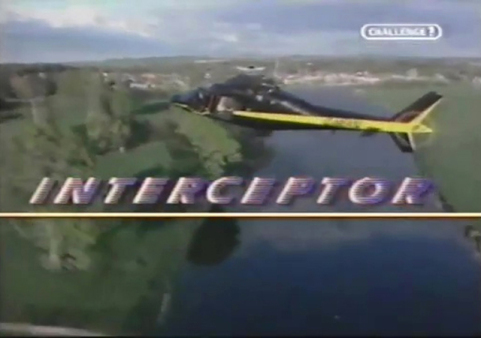
Having tackled Treasure Hunt, it would be remiss of me not to cover Interceptor, which was very much a sister show; albeit the much less successful black sheep sister, showing up to grandfather’s funeral with a wild hangover, and falling into the grave while sparking up a rollie. Like all the best game shows from that era — Treasure Hunt, Crystal Maze, Fort Boyard — it’s adapted from a French series created by Jacques Antoine, and shared Treasure Hunt‘s production team and crew, from helicopter pilots and iconic run-and-gun cameraman Graham, to its host, Annabel Croft, who’d replaced Anneka Rice in the final series. But Interceptor had something neither Hunt nor most game shows could brag — a villain — and not in the Barrymore sense of future disgrace, but with the titular Interceptor, as portrayed by Scottish actor and model, Sean O’Kane.
Interceptor ran for a single eight-episode series on ITV in the summer of ’89, sandwiched in the gap between Treasure Hunt ending and the debut of Crystal Maze. The opening credits feel more like a buddy-cop action series, with energetic shots of swooping helicopters, and a man in a Colombine jacket somersaulting over a gate. Its theme is impassioned classical piano, in a shameless rip-off of Chopin’s Revolutionary Etude, with added thumping basslines and synthesised strings, in the perfect soundtrack to running out of a burning museum. If you’re looking for something to ask the DJ for when clubs open again, it was released as a single, with a b-side of the non-piano parts titled Interceptor Boogie.
[image error]
I assumed, with its action trappings, this couldn’t possibly be as posh as Treasure Hunt, and yet we open with Annabel Croft stood in front of Leeds Castle (confusingly located in Kent), “known as the loveliest castle in the world.” What’s the criteria for that?! Turns out, the show is so middle-class, watching has me feeling more like Stig of the Dump than ever; my snot-crusted nose pushed against a Victorian shop window, while back at my hovel, another supper of dried-out dog muck goes cold. This week’s contestants are a married couple called Candy and Mark. She’s backpacked around the world and climbed Kilimanjaro — “well done!” says Annabel — while he’s a copywriter, who, when asked if he’s sporty, mumbles “I like to watch a lot of motor racing and horse racing, things like that.” That’s a no, then. Should they win the £1,000 prize, they’ll do what any of us would with such a windfall, and buy a new sofa. God, I hope the Interceptor’s using live rounds.
Perhaps symbolic of the colonial guilt from the crimes of their ancestors, the yuppies are absolutely weighted down with equipment, each with two heavy duty housebrick-sized mic packs strapped to their chests, with 18 inch rubber aerials, plus headset mics and a Rob Liefeld assortment of boxes and batteries on their belts. Added to these are bulky suitcase backpacks with sensors on the rear, one of which contains the £1,000, the other just the equivalent weight, so neither knows which is which.
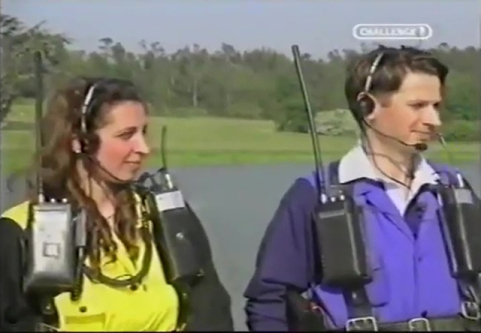
When we’re introduced to the Interceptor, he’s lounging outside an enormous country house, convertible parked nearby with the licence plate INT 1, bottle of champers in an ice bucket, and lazily swilling from a glass, like an assassin waiting for the next call. O’Kane viewed the character as “a wealthy futuristic Viking, wreaking havoc on mere-mortals for simple sport,” and his look is decidedly Aryan, with stark blonde hair and a full black leather ensemble, gloves and all. The original concept was to stick him under a Darth Vader mask, but that never made it onscreen.
For the hunt, he’s armed with a wrist-mounted laser, with heavy Nintendo Power Glove vibes, from which he’ll be shooting at the contestants’ backpacks. It’s explained by Croft as an infrared sensor, like a TV remote; tech which was apparently acquired from the British Army — I suppose for when they needed to change the barracks telly over to that funny Jim Davidson. As we’ll see, its range is… not quite as promised by exciting clips of him doing drive-bys out of a speeding helicopter.
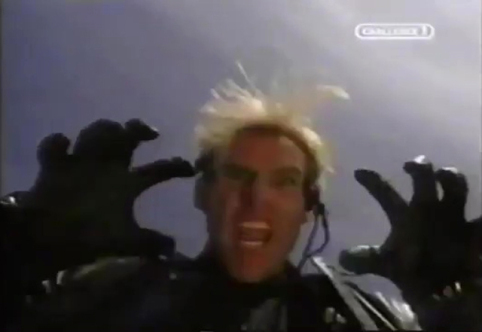
Probably the main thing anyone remembers about the show is the Interceptor’s catchphrase, which isn’t even a word, but a noise; the screeching “AAAAAHK!” of a giant bird, accompanied by raising his arms like wings, as though doing The Karate Kid in a game of charades. Many times it’s obviously been dubbed on in post, much clearer and louder than the ambient sound, giving it an unnatural quality, like, is that coming from the TV, or inside my own head? Though it’s instinctively emitted when spotting a contestant, the screech has many meanings, functioning as warning, jubilant cry, intimidation tactic, and howl of frustration. Christened the ‘fish-eagle,’ its genesis was described by the man himself in a 2002 interview with the Interceptor’s Lair Fan Site:
“In my primary school days, I lived in a world of fantasy and on any given day would lose myself to imagination. E.g. whilst my class mates played football, I was perched on a wall pretending to be a bird of prey and would swoop on any ball sent out of play.”
Fair enough. The game begins with Candy and Mark being shepherded into the chopper to be blindfolded, but it’s all so bloody hoity-toity, Croft tells them “don’t worry!” and they wish the pilot a cheery “hello,” somewhat undercutting the tension of this thrilling air-to-ground chase by a maniacal man-bird. They’re dumped out separately, seven miles apart, and the aim is to each locate and collect the key to their partner’s case, before meeting up to (hopefully) get them open, all while avoiding the Interceptor, whose laser-blasts will lock the cases permanently with a direct hit.
[image error]
Croft operates as guide, moving plastic figures along a map at base-camp (a desk plonked in the middle of a market town high street), and directing them towards areas they might ‘find’ transport to move them between locations. If you take out the Interceptor, it’s barely a game at all, with no clues or questions, and no puzzles to be solved. It’s more of an immersive experience than a game show, like those haunted farms you can walk through on Halloween, where zombie scarecrows leap out of the corn, or the old Alien War thing at the Trocadero.
Following Treasure Hunt‘s RPG feel, there’s a heavy use of plants, hanging around waiting for contestants to find them, so they might offer to aid in their quest. Mark’s first stop is a pub where he needs to find a speedboat to cross the river, and it’s just a matter of bothering random members of the public — like a shirtless old boozer with Derek Acorah hair — until locating the correct NPC. Way down the map, Candy bumps into a milkman, who just happens to be stood by his float, ready for her to clamber into the back for a lift, like Kat Slater coming back from a one night stand. All the vehicles are open-topped, with a lot of flat-beds, both to avoid having to cram a cameraman in the footwell, and so they can be seen from the air by the Interceptor.

While he’s on the hunt, we’re treated to scenes of the master/subservient relationship he shares with his pilot, who always refers to him as “guv,” like Nookie Bear. There’s lots of scripted banter, such as asking for an increase in his “map allowance… my money to buy maps, govnor,” or being told off for having a dirty windscreen. The helicopter is an ever-present shadow over proceedings, an Eye of Sauron which has contestants jumpy at every distant thrum of approaching rotors, watchful of the skies, and careful not to give him their backs. While searching for the boat, Mark lets out a sudden cry of “Oh, God, it’s the Interceptor!” ducking behind a wall, and the big man regularly takes aim from above.
Here’s where expectation meets reality, at fatal speed. On paper, it sounds very exciting, with contestants throwing themselves in ditches as he whizzes by, blasting away all Boyz n tha Hood, but there’s no indication anything’s happened. No explosions, no superimposed laser beam; nothing barring the sort of dubbed in “pew pew!” noises you get when a character in EastEnders is playing an unseen video game. Nobody knows if he’s hit the cases until they try and unlock them at the end, and the tech is so primitive, for all its promises of mowing them down from above like Apocalypse Now, the gun pretty much has to be touching the target to connect. When he does catch Mark, it’s by sneaking up from behind down a country lane and shooting him point blank in the back.
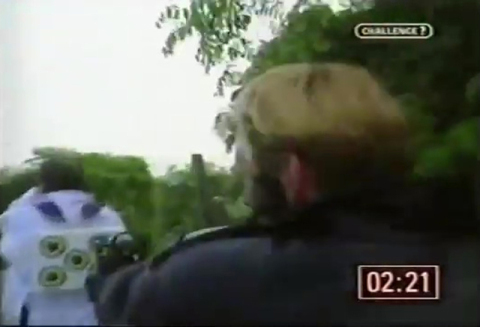
While the Treasure Hunt viewing experience was often a mess of voices and frenetic cuts between its dual teams, Interceptor‘s makes you yearn for such tranquillity. Breathlessly rattling back and forth between four locations, there’s between one and three people yelling at all times, either puffed out from running, or trying to be heard over the noise of engines, together with helicopter blades and a grown man imitating a bird of prey at the top of his lungs. At the game’s midpoint, Croft is shouting instructions to Candy, who’s sprinting through an orchard, while Mark’s huffing and grunting can be heard through the headset from miles away, as the Interceptor loudly patrols the skies.
Its one concession to game show mechanics is requiring contestants to win their key through a physical task. For Candy, it’s having spear it onto a lance at a jousting tournament. Endemic of Interceptor‘s poshness is how the elderly cosplay knight just assumes she can ride a horse, instructing her to keep the lance “over the horse’s withers,” (a term I had to Google), and letting her get on with it. I’ve barely even seen a horse in real life, let alone ridden one. “Withers, you say? Got it. One quick question before I get on, what are ‘stirrups’ again, mate? Also, how do I start it? By tugging on its cock?” She nails it first time, before asking a couple of poshies having a picnic — tartan blanket; literal wicker basket lined with silver cutlery — if she can have a borrow of their vintage Rolls Royce, and is soon pelting away, chauffeur at the wheel.
[image error]
By now, as he must if he wants to hit the sensors, the Interceptor’s stalking her on foot, and surely being baked alive in his incel leather trenchie. Any time he’s running, coat flapping like a cape, it’s very Bishop Brennan after realising he was kicked up the arse — “Crillaaaaay!” With Candy off in the Rolls for a jolly old jaunt, what-what, yer man’s got no choice but to ‘steal’ a white horse from a medieval maiden, for an exciting car/horse chase. Noticeably, you don’t see his face as he’s galloping after her, not until a tightly edited close-up of a rare horseback fish-eagle, in a manner reminiscent of that winning Apprentice candidate’s ‘reverse pterodactyl’.
But with Mark faffing around retrieving his key from a beehive, time runs out before the pair can meet. Interceptor lets out a victorious “AAAAAHK!” and the losers are handed a commiseration prize of an “Interceptor adventure pack,” aka a cardboard box containing binoculars, a compass, and a map of Kent, if you’re curious what constituted adventure 30 years ago. Incidentally, Mark’s still wearing the bee-keeper suit — or as he calls it “a bee-hive man’s… thing” — which, pulled over his walkies, gives him some lovely, pointy Mulligan & O’Hare breasts. Perhaps because of first time nerves, Annabel Croft’s breathless goodbye is hilariously rushed and abrupt.
I did watch a second episode, notable for really showcasing the way it scripts all of its interactions, and runs the whole thing on rails — which isn’t necessarily a bad thing. The Interceptor beats contestant, Hilary, to the farm she’s headed for, bunging a tenner to a central casting farmer to borrow his tractor and clothes, in a tribute to Terminator. “I need your flat cap, your Nigel Farage body warmer, and your tractor.” Directed to the vehicle, Hilary climbs in the back, unaware the Interceptor’s at the wheel, and when he pulls over to let her out, some miles down the road, he’s right behind with a “pew pew!” and an “AAAAAHK!” Although, sketchily, the Interceptor’s got his own cameraman, who Hilary somehow didn’t see, as he stood alongside him in the cabin, filming her through the tractor’s open back window the whole time.
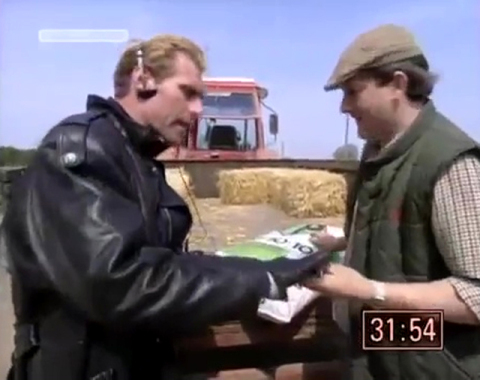
Also of interest is Hilary’s partner, Martin, an upper class twit who plans to spend the prize money on “a whoopie party!” and runs down the ticking clock wittering away to himself about pheasants and shrubbery — “absolutely beautiful, very attractive” — while ambling about the countryside. In another cracking piece of 1980’s health and safety, his key’s at the top of a fountain, which requires a trip up a 30ft ladder before clambering onto flooding stone steps, in scenes which make John Noakes’ trip up Nelson’s Column look like your mum climbing into bed to finish her latest Maeve Binchy.
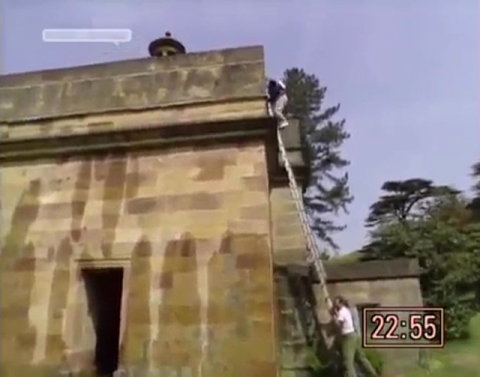
He’s tracked to a stately home, hiding behind pillars, with shots of the Interceptor spreading his leather wings like the fucking Mothman. There’s great juxtaposition of the screeching hunter lumbering towards Martin, who’s chattering to himself as he backs away, reading aloud from signs on the wall — “Sorry No Dogs” — while Interceptor hurdles over red ropes in his Matrix coat, all “AAAAAHK! AAAAAHK!” by old ladies sat having scones in the cafe. Martin makes his escape into a horse and carriage with GAY GORDON written on the side, loaded with lads in top hats, and a bugler. “Don’t often have twits like me on here, do you?” says Martin. Alas, they run out of time, so Martin doesn’t get to burn the prize money in front of a homeless man for a joke. Interceptor (or someone in his coat), bombs by on a motorbike, waving a victorious fist and very nearly crashing into a car.
I know Interceptor is fondly remembered, but if you take out the fish-eagle, it’s just another show where posh people look for someone to give them a lift. This is what the 1% did to fill their empty days before they all opened candle businesses. Even with the Interceptor, the limitations of its central technology turn the whole thing into a game of tag; effectively just Treasure Hunt meets Laser Quest, but instead of everyone going for pizza after, it’ll be roast quail served by some poor sod who gets bullied for the whole meal and left a biography of Thatcher as a tip.
[image error]
In April of 1989, pre-dating the British version by three months, an American pilot aired. Rebranded as the more highfalutin Interceptor — The Game of High Adventure, the show was hosted by Erik Estrada from ChiPs, with Interceptor wearing the Darth Vader style mask dropped from the British series, complete with vocal effects and an inbuilt POV camera. It never went to series, which is a shame, considering this intriguing quote from its producer at the time, Ron Ziskin, suggesting they may have regularly changed the big man’s look: “One week, he could be RoboCop, the next, GI Joe, or the Lone Ranger.” Now there’s an idea crying out for a reboot, updated with contemporary villains. Slender Man, Pennywise, Thanos; come on, Netflix, say the word and we’ll have a hedge fund manager called Peregrine being chased over the grounds of a stately home by a man in a tracksuit with a massive cigar. AAAAAHK! AAAAAHK!
…
This piece first appeared on my Patreon, where subscribers could read it a month before it landed here. If you’d like to support me for as little as $1 a month, then click here to help provide the world with regular deep dives about weird-bad pop culture, early access to my podcast, and all kinds of other stuff.
There’s a ton of content, including exclusives that’ll never appear here on the free blog, such as 1970’s British variety-set horror novella, Jangle, and my latest novel, Men of the Loch. Please give my existing books a look too, or if you’re so inclined, sling me a Ko-fi or some PayPal cash.
May 8, 2021
Phil Cool
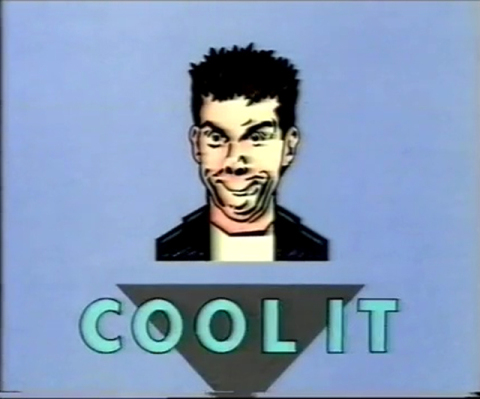
When writing about a certain type of comic performer, there’s a phrase all media is obligated to use, or else the Secret Critic Police will kick in the doors and drag them off to the gulags. There’s even an ancient proverb about it — “If wild expressions you see, then ‘rubber-faced funnyman’ they be!” Putting that exact phrase, rubber-faced funnyman, into Google throws up a bunch of names; predominantly Jim Carrey, but also Lee Evans, Jim ‘Ernest’ Varney, Rowan Atkinson, Roberto Benigni, and Martin Clunes. There’s one more name, easily the most rubber-faced of all, but which hasn’t been spoken aloud in many a year.
Though a genuine mainstream star in his day, Phil Cool’s been largely forgotten in the 21st century. He occupied a rather singular space, and barring the odd Royal Variety, didn’t really mix with other shows. Once he got his own series, as demonstrated by a frugal page of credits, he never ventured outside of them as a performer, making no guest appearances, and just a handful of interview spots. Cool It was a similarly separatist endeavour, and in a run of 15 episodes from 1985-1988, there are scant few additional cast members listed; all brief celebrity cameos like Ian McCaskill and Geoff Capes, while the first series was written solely by its star.

Perhaps this should’ve been part of my Past Laugh Regression series, considering how much I enjoyed Cool’s work as a schoolboy, with me and my young chums futilely attempting to mimic his snorting Devil face in the playground to freak each other out. Cool It debuted on BBC2 on August 30th 1985, with a budget that makes Who Do You Do? look like Waterworld. This isn’t just lo-fi, it’s the cheapest television possible; at least until the pandemic turned every channel into Celebrity Chatroulette. A true one-man show, the entire first episode is a single, 23-minute routine, with Cool in a spotlight on a spartan stage, in regular clothes, and with no props beyond an eventual pair of glasses and hook-on beard.
In settling on these for a rewatch, I had assumed that, like everything else from childhood, where bullies were ten feet tall, and everything was either the best or worst, my memories had overplayed his rubber-facedness. Surely it hadn’t been that extreme? This was the ’80s, when we were but an innocent species, wowed by commercials with talking cats and yet to discover pegging, so I’m sure everyone just got carried away. But no. If anything, it’s more impressive than I remembered. A real-life Faceache from Buster, Phil Cool genuinely seems to have no bones in his head, forming and shaping his mug at will, like one of those weird elderly man hand puppets you could buy from newsagents. Even his body, hunching his shoulders up by his ears and telescoping his neck as ET, seems unregulated by the rules of human biology. God only knows what he can do with his nob.

But does the material match the physicality? Every impressionist is beholden to the scales of comedy, which weigh quality of voices against quality of jokes, and the ratio is typically only balanced when both are bad. The other fear is always that it’ll be the same half dozen celebrities everyone does; Frank Spencer, Norman Wisdom, Frank Bruno; Prince Charles robotically moving his arms and going “err…” I’m quite delighted when this turns out not to be the case, with Cool’s roster of voices including luminaries such as Mr. Kipling, the Pope, his old teachers, Arthur Scargill, Robin Day (a popular one, granted) and a drunken Lawrie McMenemy unable to pronounce his own name.
The material’s a pleasant surprise too, and with unexpected bite, made all the more disarming by its languid delivery, as Cool takes his time in a slow, soft-spoken Lancashire drawl. One section would incite a flood of coordinated complaints from evangelicals in 2021, where he talks about being “cheated out of an education” at his old school, “where religious instruction took precedence over every other subject… so consequently, when you left the damn place, you were thicker than when you went in.” He takes digs against nuns, walking into the jungle to convert happy, well-adjusted tribes of pagans “into a bunch of unhappy, confused, sickly, westernised Christians,” ending with a punchline where a Tarzan yell segues into Ave Maria. Then there’s an impression of a Jehovah’s Witness walking the streets like a town crier, bellowing “AIDS epidemic spreads by blood transfusion; we told you so!”
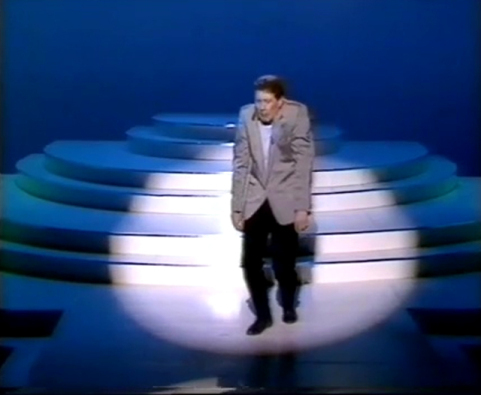
The crowd are right with him, until the question “talking about religion… what about this pope?” elicits awkward murmurs. “He’s a right little belter,” says Cool, “very cuddly,” before an impersonation where JP’s chatting to the cardinals at the bar about going to the chippy. He doesn’t hold back in his political gags either, with a Question Time skit that feels contemporary, satirising the format, guests and audience. There’s a pop at Thatcherite Tory Sir Keith Joseph (Day: “I’m not frightened, I’ve got my clove of garlic and my crucifix!”) and lines that tackle the disparity in pay rises between top civil servants and teachers, with Sir Keith blaming the top salaries review board; “and tell us, Keith, who sits on the top salaries review board?” (note: it’s him) Scargill recites a Trade Union-themed Lord’s Prayer — “…and deliver us from Thatcherism” — and there’s even stuff about climate change and fossil fuels, in 1985! Phil’s an ally, and we Stan the rubber-faced funnyman.
Although, you can’t ever get 10 minutes in these things without a Yewtree, so there is a bit with Rolf redecorating the Sistine Chapel, retroactively tainting every line with beastly innuendo about “little cherubs.” The following year, Cool would go onto release a single as Rolf, with a cover of Bridge Over Troubled Water; a track filled with Rolf’s weird little asthmatic noises, taken from comedy album Not Just a Pretty Face. Probably don’t make it the first dance at your wedding. As a whole, the first episode of Cool It is a really enjoyable watch, with the 36-year-old material holding up wonderfully, as it’s not just a slew of empty references to people and things, and all coupled with the uniqueness of Cool’s absolutely grotesque Scrunges. Unfortunately, it’s all downhill from here.

We skip forwards a year to the second series, co-written with Jasper Carrott. Carrott’s a looming figure in the career of Phil Cool, as a mentor of sorts, following an early bravura performance at Carrott’s folk club, The Boggery. In the 90s, they’d tour together as Carrott and Cool, but here, Carrott’s presence remains behind the scenes, other than a recognisable, uncredited cameo as an offscreen voice, yelling for Cool to get off the stage during a performance of Blowin’ in the Wind (which ends with Cool’s Bob Dylan snorting an unspecified substance off a harmonica). Carrott’s voice is heard most strongly in the material, which plays like a cover version of his folksy shaggy dog stories, in routines rescued from the bottom drawer. There’s a long section about playing rooms “full of plain clothes morris dancers” and “pigeon-chested pigeon fanciers,” and a bit about a guru, “rattling his joss stick and smoking his kaftan.” What’s Phil gonna do in episode 2, sire Dawn from The Office?
Gone is the unique voice of the first series, replaced with this Carrott-karaoke, while the delivery’s changed too. It’s all gotten faster, louder and sweatier, like those horrible VHS tapes of American comics wearing big suits in night clubs, damp mullets swinging as they mime the waddle of an overweight person they saw in the supermarket. Even the face-pulling’s massively reduced to mere punctuation on incredibly poor punchlines, like a bit about STDs in “the itchy 80s” with a rare impression of “the herpes simplex virus” as it lays dormant in the carrier’s neck. I mean, I know I didn’t want all the cliched voices, but this is some monkey’s paw shit.
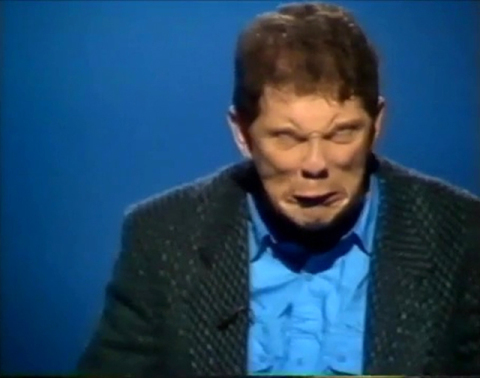
I’m assuming anything that’s… unCarrotty is Cool’s half of the writing, of a rushed quality which suggests the first series used up all the tightly-honed material he’d been doing in clubs for years. A bunch of time’s devoted to country singer George Hamilton IV [monkey paw closes another finger] and the Grand Ole Opry, before going all Rory Bremner with the old “imagine if Roy Hattersley were a country singer!” as Roy “splatters me Hattersley” spits everywhere, in that bit nicked from Spitting Image where Cool used to work. There is one great nob gag, about going “round this whole country, scouring for new talent… and I got boxcar willy!” Though it’s absolutely ruined by the follow-up “some people say it’s my fault for sleeping on freight trains!” For those who still don’t get it, willy is slang for penis, and Webster’s Dictionary defines a boxcar as…
What we really want is the funny faces, and without them, it’s Peter Kay not reminding you of things, or Chubby Brown never once mentioning his wife’s smelly fanny. Instead, we get jokes about eating chicken in a basket; “they’d finished the chicken, they were onto the basket!” C’mon, Phil, get a gurn on! Yank your foreskin over your head! Maybe things will improve by jumping forwards to 1988’s final series. Spoilers — they absolutely don’t. Though Carrott’s not providing gags, there’s additional credits for three other writers, which would explain the unfocussed, scattershot nature, and the jokes; oh, the jokes! “Anyone ever un-streaked? Ran through a nudist colony fully clothed?” and “last night, me daughter came home with a yo-yo… I think his name was Brian!”

The satirical rage, once pointed at the grand establishment, now sets its sights on stamp collectors. “How can anyone get worked up about a little piece of gummed paper?!” he rages, miming a protracted orgasm-into-heart-attack while inspecting a stamp under a magnifying glass. He talks about fashion and flared trousers; “I thought i’d go out in them, then I thought, no I won’t, I’ll go far out in them!” There are impressions, but one’s a Kinnock in a routine about deely bobbers and “what if the labour party wore one?!” In the last episode, he’ll submit to fate and do a Prince Charles; arms moving robotically, an “errr” croaking from the side of his mouth. This is Impressionist Hell; Satan in a beret going “ooh, Betty!” As every mimic risks the guillotine should they fail to bring them out, Sean Connery shows up, along with Norman Wisdom, falling over and yelling for Mr. Grimsdale. Almost a full minute goes to Cool rolling around on the floor, making the grizzling Norman Wisdom noise.
Where series three differentiates is with actual sketches, and suddenly cutting away from the stage for the very first time to an actual beach has me trying to climb into the screen for a paddle, like those audiences in 1895 running in fear from a silent train. But then, Cool’s metal detecting geek in coke-bottle glasses says “hello!” in the standard Mr. Bean nerd voice, before digging a ring-pull out of a massive hole. There’s a Parkinson skit, interviewing George Mellie in split screen, with a jarringly homophobic opening, telling his guest to “grab a seat,” as Mellie replies “so do I, Michael.” Parky keeps picking his nose, while Mellie does a squeaky fart. Rolf comes back, playing a “didgeridon’t” and turning into a werewolf. There’s a close-up of a hairy hand grasping at the set as we zoom in, and…
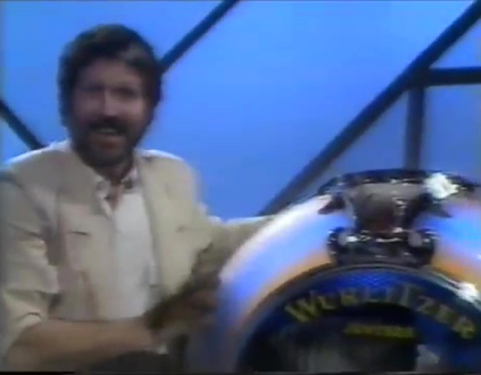
First Rolf, and now this — double-Yewtree! And in four episodes, he’s the first supporting artiste to show their face. At this point, we reach the absolute nadir, as DLT selects a song on the jukebox from The Four Bottoms. For reasons of TOS, I’m limited in what I can show in illustrative pictures, but imagine as best you can, a man’s bare arse twitching in time with a “bum bum bum” backing track. More arses fill the screen, superimposed either side of Phil’s head, as he sings the delightful refrain “you may see me moving in the moonlight, tryin’ very hard to get my mooning right.” Yes, a romantic ballad about getting your arse out — “I’m mooning, mooning my way into your life” — where Phil’s face at a window dissolves into a horrible aul hoop pushed right up against the glass.
Can I point out that this isn’t even mooning? They’re just naked. Mooning’s when you pull your trousers down, say, in front of a local deputy headmaster and his wife in Sainsbury’s when they’re out doing the Friday big shop, because they left you a bad book review on Amazon, and six months later there’s a picture of you in the paper trying to cover your face with a Paw Patrol backpack outside of court, with the headline BUM NOTE BY LOCAL ‘AUTHOR’ — SUSSEX MAN BANNED FROM HIGH STREET FOR 10 YEARS. Anyway, then there’s two big twitching arses, in full side profile, with Phil’s little head inbetween, all lit like Bohemian Rhapsody. As best they can with late 80’s video effects, it ends with Phil’s head going right up one of the bums, before a parody of Smith and Jones where he’s talking into a man’s bare ricker. The remaining stand-up’s no better, and from the fun of series one, it’s now the full Geoff Tipps — “...Medusa sat there…” — with hacky routines about jogging, contagious yawning, and a trip to the swimming pool; lanes filled with slow old people, used plasters floating by, and “a verruca up the bazooka! (his anus)”
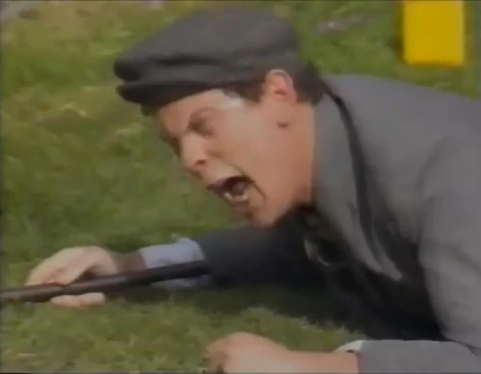
Of course, there’s a pop at Arnie, milking the decade’s undying obsession with the comedy value of his surname; only pumping up his chest so he can fit it on a t-shirt, and “we’ve seen him as the TerminaTOR, the PredaTOR, I don’t suppose we’ll ever see him as the acTOR!” From great-ish heights, the final half-hour reduces Cool to a yell of “D’YA EVER TWIST YOUR ANKLE?!” while doing a funny walk, admittedly to massive laughter. Ironically, I can imagine it was the sweaty physical comedy which appealed to me as a kid, rather than his early work about the evils of religion. In the last episode, there’s a bit I remember stealing, in my days as irritating class clown, where he pretends to swallow a bee, eyes bugging out, tongue stabbing wildly against the inside of his cheeks to suggest it’s flying around in there. I’m racked with a horrible shiver of embarrassment, and head to YouTube’s comment section for respite.
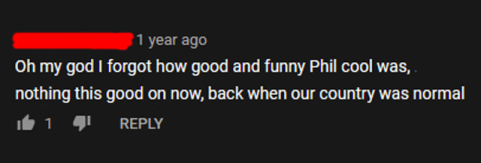
Normal! These days, old comedy — any old comedy — has that lot latching on like a lactating breast. The Grumbleweeds and Les Dennis; even Syd Little who’s just standing there; no longer just very poor comedy acts from television past, but devastating A-bombs in the culture war. You can’t even shout “Mr. Grimsdale!” while pretending to fall down the stairs these days without getting thrown in prison! Speaking of normal, what must Phil Cool look like now? We’ve all seen those old trumpet players with sagging cheek pouches. Shockingly, having retired in 2013 after decades of deforming himself, Phil Cool looks like a regular old bloke, and not, as I’d assumed, a Dick Tracy villain called Ballbag Benson. Though he’s unlikely to show up on TV again, I do recommend revisiting the work of Phil Cool, just keep in mind the quality is like the position of his facial features, and varies wildly.
…
This piece first appeared on my Patreon, where subscribers could read it a month before it landed here. If you’d like to support me for as little as $1 a month, then click here to help provide the world with regular deep dives about weird-bad pop culture, early access to my podcast, and all kinds of other stuff.
There’s a ton of content, including exclusives that’ll never appear here on the free blog, such as 1970’s British variety-set horror novella, Jangle, and my latest novel, Men of the Loch. Please give my existing books a look too, or if you’re so inclined, sling me a Ko-fi or some PayPal cash.
April 28, 2021
The Accursed 90s – Beat The Crusher
[More Accursed 90s: Televised Lad Contests — Don’t Forget Your Toothbrush — Talk Show Goths — James Whale on Television — Craig Charles’ Funky Bunker — The Word — The Girlie Show — An Accursed 90’s Christmas — Endurance UK]
My latest video essay takes us back to the era when TV shows hated their audiences, who in turn loved the abuse, as we explore the destructive chaos of late 90’s Freddie Starr vehicle, Beat the Crusher.
…
This piece first appeared on my Patreon, where subscribers could read it a month before it landed here. If you’d like to support me for as little as $1 a month, then click here to help provide the world with regular deep dives about weird-bad pop culture, early access to my podcast, and all kinds of other stuff.
There’s a ton of content, including exclusives that’ll never appear here on the free blog, such as 1970’s British variety-set horror novella, Jangle, and my latest novel, Men of the Loch. Please give my existing books a look too, or if you’re so inclined, sling me a Ko-fi or some PayPal cash.
April 18, 2021
Metal Mickey

Metal Mickey was a notable figure during my time as a small boy, due to his fitting solidly within that best and most formative of all categories — things I liked but was also a bit afraid of. I think it was the voice; clanging and metallic, like a ghost calling to you through the overflow, and a bit too Darth Vader-y for a child whose greatest fear was Luke’s aul’ fella. Not too coincidentally, Mickey originated as a way of pumping out novelty singles in the midst of Star Wars fever, as the brainchild of guitarist and former Bowie bandmate, John ‘Purpleknees’ Edward (I dread to think the story behind that nickname), who worked the controls and did the voice. The success of Mickey’s cover of Lollipop led to a string of guest appearances, on shows like Game for a Laugh, Russ Abbot’s Madhouse, TISWAS, and inevitably, Jim’ll Fix It, before landing a permanent gig on Bill Oddie’s Saturday Banana.
Note that Mickey is always credited as ‘himself’. In Anthony Daniels’ wonderfully self-obsessed autobiography, (which has, like, two references to Kenny Baker, one simply reading “the diminutive actor cast to animate some of Artoo’s scenes”) he complains about the way the droids were promoted in their numerous TV appearances following the first movie. While Carrie Fisher, Mark Hamill, and even Peter Mayhew were listed under their actual names, the droids were always “as themselves,” to keep the magic of suggesting they were real. Similarly, when Mickey span off into his own series on LWT, his credit read “METAL MICKEY appears by arrangement with HOLLYWOOD ROBOTS.” Thus, Metal Mickey the sitcom isn’t the origin story and wacky home life of the Mickey from Saturday Banana, but rather, a show that he’s simply acting in, like when Will Smith got plucked from rap to do the Fresh Prince.
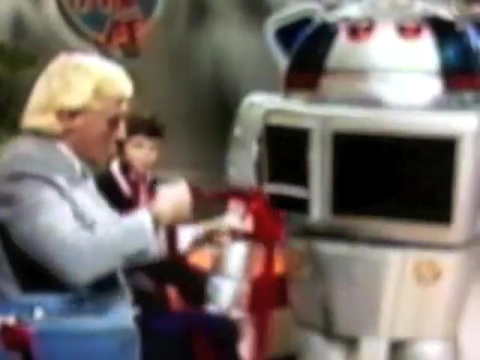
The series has a weird pedigree, created by Humphrey Barclay — after spotting Mickey on Jim’ll Fix It — written by perennial 80’s gagsmith Colin Bostock-Smith, and produced and directed by Mickey Dolenz from The Monkees, presumably drafted in to bring some of that wacky musical sitcom flavour. Landing his own show really solidified Metal Mickey’s role as our Robby the Robot, but unlike the sleek metal lads from Star Wars, his design has a beautifully British clunkiness, with a squat, primate’s frame, like Dominic Littlewood in a silver marathon cape. There’s nobody inside; nobody ‘wearing’ it; essentially rendering him a real robot, albeit operated with an iffy 1980’s remote control. He’s got tufts of coiled wire for hair, and chest panels with coloured lights, which flash in spacey shapes and the phrase COSMIC ZONE. Despite the name, he’s very plasticy, and moves via castors on the bottom of his static legs, though the upper body and head can spin 360 degrees independently, meaning — if he so chose, and if he’d been retrofitted with an anus — Mickey could’ve watched himself defecate.
Episode one, entitled Metal Mickey Lives, aired on September the 6th, 1980, in the Saturday tea-time slot. Unsurprisingly given its creative team, the theme tune — the buried memory of which instantly unlocked within a single note — is an absolute banger, with a chugging guitar riff and swooshy robot noises. According to the lyrics, he weighs half a ton, which must play havoc with the floorboards. As inferred by the episode’s title, Mickey’s a mere husk when we begin, yet to be sparked into life, and the first half’s all about establishing the human family, who’ve got the very sitcom name of Wilburforce. But the living arrangement’s strange, with three grown siblings — two brothers and a sister — sharing bunk beds in a single room. There’s punk teen Steve, with studded bracelet and neckerchief; bespectacled boffin and Mickey’s inventor, Ken; and sister Hayley. As with all TV, they’re clearly adults playing younger, but Ken and Hayley are meant to be doing their A-Levels, which gives the mixed-gender bunks the air of a commune rather than a family home.

Conversely, while Ken (classic teen name) looks 35, the mum was a youthful 31 at the time of filming, and the dad looks old enough to be her father. But the thing that immediately stands out is the fucking ludicrous size of the house. As a consequence of having to manoeuvrer a lumbering great robot through it, every room’s like an aircraft hanger, with enormous spaces between the furniture. The dining table’s about 20 feet back from the wall, surrounded by a desert of empty floor, and one low-angle shot of father stood on a chair reveals infinite walls rising to the heavens. The off-kilter proportions give it a sickly vibe, like sleeping off mumps and staring at an Artex ceiling that’s a hundred miles away. Also, on closer inspection, all the ‘carpet’ is just lino patterned to look like carpeting, allowing for the roll of Mickey’s wheels.
After the opening titles end with the simply delightful words “and Irene Handl as Granny,” we begin on Ken tinkering with a dormant Mickey, while Granny plays darts with punky Steve. On rewinding, as Granny gets out of her wheelchair, it tips as she leans on the handle, almost sending the 79-year-old Handl over. They’re joined by neighbour Janey, who enters through the window, in a trait connected both with cool and quirky sitcom characters and with Ted Bundy. Highlighting Mickey‘s eclectic roster, Janey’s played by Lola Young, or to give her full contemporary title, Baroness Young of Hornsey, a life peer in the House of Lords. Is Baron Ponsonby of Roehampton about to crawl in through the catflap?
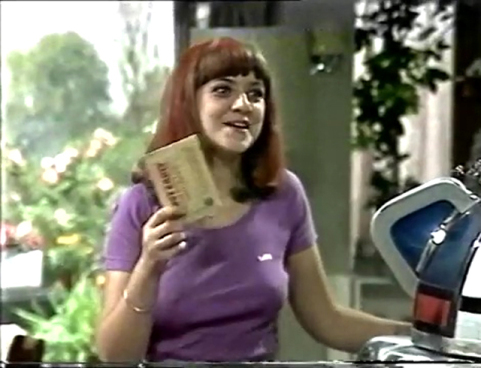
Mickey’s being built to help mum with her chores, and good job too, as she’s a pure sitcom housewife, never without a feather duster, and living to cook, clean and pick up after her pipe-smoking, building society manager husband, who’s such an old sexist, he has to be reminded they’ve even got a daughter. Speaking of the daughter, her ‘thing’ is having small boobs, borrowing Granny’s tape measure to see if they’ve grown since yesterday, only to be burned with “I seen larger gooseberries!” This is returned to repeatedly, but — how to put this without sounding like a perv? I mean, the actress is an adult, so I’m probably fine — they’re noticeably not small, especially going by some of the YouTube comments. It’s a bizarre thing to keep harping on about; doing exercises to make them grow, while Janey cheers her on, and Steve does a tit-pun and mimes a wazzo pair of jugs. Along with everyone pretending the cast are children and the house isn’t gigantic, Metal Mickey‘s one big gaslighting experiment. I bet if you really looked, Mickey was actually made of paper.
There’s a strong parallel with Saved by the Bell and Screech’s robot, Kevin, in Ken’s project, which in a Woolworths take on the Frankenstein myth, sparks into life when Janey pops a sherbert-filled sweet into its mouth. Even now, I can see why the voice frightened me so as a child. It’s all done with vocoder like Peter Frampton, but with an utter lack of intonation; every line completely flat, and making Stephen Hawking sound like Matt Berry. Half the time, you have to run it back to decipher what he’s saying, while the other half, no clue. It sounds like someone banging two metal pipes together.
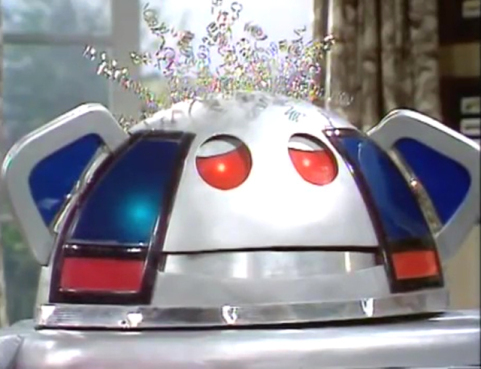
Declaring “Metal Mickey lives!” as the puny humans back away in fright, his first act as a self-aware entity is to return Hayley’s compliment with “you’re not so bad yourself, stringbean,” and scanning his eyes up and down her breasts. “Oh, you’ve noticed,” she says, once again sad about her tits. Mickey recommends “comfy sweaters and tight cords” before winking, the steel paed. There’s a debate about gender which inadvertently feels quite modern, with the kids asserting that smooth-crotched, nob-less Mickey is “not exactly male, is he?” which he counters with simply knowing that he’s a male. Although it then dates itself with a gag about the shame of being born to an unmarried mother.
So’s not to freak out the parents, the kids pretend Mickey’s being controlled by Ken, during a dinner scene where everyone’s crowded round one side of the table like the last supper. After Mickey almost ploughs through the patio doors, dad orders him to leave, because “it’s a small bungalow, and there’s not enough room for a robot.” No room? Your house can be seen from space! You need a week’s supplies to walk over and switch the telly on! They plan to impress dad into letting Mickey stay by having him clear up all the “choss.” I’d not heard that word before, but dad says it about a hundred times — “it’s choss in here, absolute choss, get it cleared up!” — and it seems to mean general untidiness. Mickey wins him over by telekinetically floating “two buckets of choss” (specifically, laundry) off the floor, before accidentally wrecking his beloved greenhouse for the classic sitcom ending. Your man from the Monkees is credited here as Michael Dolenz. Very grown up, mate.
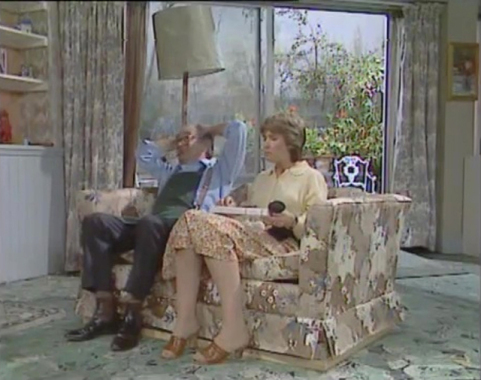
Metal Mickey is typical of shows from that awkward tea-time slot where adults will be watching but it’s ostensibly aimed at kids, in that its jokes are abysmal, like when Ken’s tinkering with Mickey and told to “watch the oil,” replying with “why, what’s it doing?” Most of the dialogue’s people being snippy at each other, especially the grown-ups, who communicate entirely in passive-aggressive sarcasm.
Dad: “Look, it’s Ken’s robot.”
Mum: “No dear, it’s the abominable snowman.”
Dad: “Silly me!”
In another episode, mum asks Hayley if she’s packing her suitcase (while watching her do just that), and dad responds “no, Marjorie, she’s making a collection for one-legged refugees!” Yeah, alright; you haven’t exchanged a tender touch in 15 years, and he only built that greenhouse for the privacy of a much-needed wank. Thankfully, there’s a ton of robot insults to be found, which long-time readers will know of my love for, racking up quite a list. Bionic dustbin, disaster on castors, iron deficiency, scrap metal on wheels, titanium twerp; it’d almost be worth sitting through all 41 half-hours to make a supercut. But three’s probably enough, and I jump forwards to episode 8, Music Man.

This is the old ‘character becomes famous pop star in Faustian deal with evil showbiz agent’ plot, when Mickey’s song Come On Boogie attracts pop manager Jake Jason, an American in a fringed leather jacket whose every other word is “baby” or “man.” Granny gets a bit Brexity, suggesting “all those with American accents should be sent back to America,” and Jake promises to give the family “something up front,” leading to another joke about Hayley’s sad jugs. Mickey’s meteoric rise is shown via black and white stock film of stream trains, passing exotic place names such as SWINDON, BASINGSTOKE and WIGAN, and spinning magazine headlines, like the Rolling Stone‘s HE’S TOP OF THE ROBOTS (and not the more phonetically pleasing “BOTS”).
Now on the A-list, in Elton John glasses and an earring, Mickey wishes his loser family an arrogant goodbye in a Mid-Atlantic accent, rebuffing Hayley’s pleas to stay — “But we love you!” “Everybody loves me. I am a star, bay-bee!” There’s a genuinely funny moment where he makes a chatshow host’s wig fly off, before realising the agent’s ripping him off. Mickey’s revenge? To telekinetically make Jake Jason’s trousers disappear — which he did to Steve in episode 1, suggesting it’s more of a fetish than anything. But Mickey’s also got the power to vanish people entirely (when he sneezes), and atchoos Jake out of existence, presumably into some sort of limbo Hell-dimension. Possessing dad’s body and forcing him to join a celebratory dance-off when he returns home, it’s clear that Mickey is more God than robot, able to do his own snap, without a single Infinity Gem. It’s likely he appeared on so many shows because everyone was terrified of him, and one wonders if the Saturday Banana gig came about when he threatened to magically fill Bill Oddie’s cock with Lego.
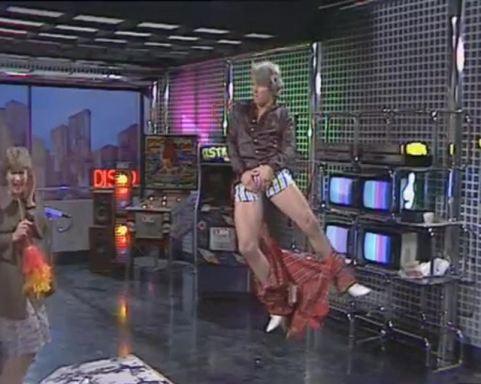
My final episode jumps forwards to series 3’s Mickey and the Future, where Mickey’s projecting Ken and Janey’s future from next week onto the telly, in one of those gags where someone’s describing what could be a sexual act, but turns out to be completely innocuous. “It is fun. She’s very good at it, she always takes control” — making it sound like Janey’s paddling his bollocks bloody. But ho-ho, they were just playing tennis. Then we forget Mickey can see through time for a plot where dad’s annoyed at Hayley taking so long in the bathroom that she must be “nice and pink and glowing now.” Janey (who’s black) opens the door with a “not quite!” An argument results in Hayley leaving home, and in a real sign of the times, the 16-year-old casually wanders off to rent a flat with her pocket money.
Now in a manky bedsit with urine-coloured tap water and resident cockroaches, the family concoct a plan to get her back home by having everyone else leave too, causing lonely old dad to beg them all to return. With the kids all gone, he calls his wife “the most stupid woman in all the world,” and she takes off too, with suitcase and feather duster. There’s no Granny this week, “on holiday in Devon,” apparently, and Handl only appeared in roughly half the episodes.
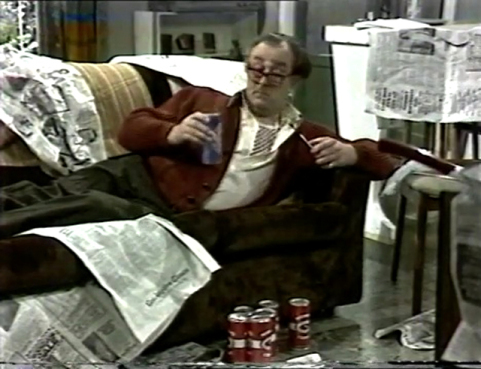
Now homeless, everyone’s crammed in Hayley’s flat and getting no sleep because Mickey keeps needing “to go wee wee,” while dad’s loving the bachelor life, boozing it up on the sofa all day. Mickey goes all Ghost of Christmas Future, showing him ten years from now if he doesn’t change his ways, living in a rat infested hovel with a filthy second wife, while his kids are off being professors (Ken), in jail (Steve), and in Hayley’s case, working as a model, for suspiciously lingering shots of her wearing a bikini. Sure, Steve’s locked up, but the others seem better off without him, and future-mum’s in bed with a hunk, so if anything, this should redouble his commitment to drinking himself to death.
Instead, he vows to change his ways, reuniting the family. It’s not clear if that was the real future, or if Mickey’s abilities include the construction of flawless deepfakes, which is a terrible notion considering how dang horny the Wilburforces are. From Mickey asking Hayley if she thinks he’s sexy, to Granny flirting with Jake Jason, to Steve’s rage when he realises there’s just next week’s tennis on the telly, and not hot footage of his brother getting pegged, along with everyone’s endless obsession with Hayley’s knockers, it’s shocking that Mickey wasn’t constructed with a fleshlight for a mouth.
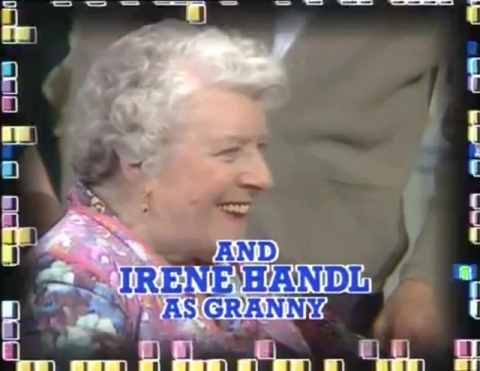
Initially, this was intended as a Shitcoms piece, but it’s not quite bad enough, with the defining quality of being another kids show which was frequently inappropriate for its intended audience. At its peak, Metal Mickey pulled in 12 million viewers, which is really just demonstrative of the lack of options back then. Running until January 1983, by the time 20 hours of hijinx had aired, the magic seemed to have worn off, and Mickey disappeared from our screens. Around 2008, old Purpleknees tried to relaunch him as a Basil Brush style evergreen brand, passing the duties onto a younger team, like Sooty had been, for a series of corporate gigs, but it fizzled out. An official Twitter account with 106 followers has lain inactive since 2015, with a handful of tweets offering personal appearances, and tagging Derren Brown in a hopeful suggestion “Metal Mickey meets the Miracle Maker!!” But I wouldn’t count him out yet. All it takes is for some creative young go-getter to snap up the rights and reboot Mickey for modern audiences, perhaps in a horror-action franchise, pitting childhood nightmare icons against each other. Mickey. Blobby. Whoever wins, we lose.
…
This piece first appeared on my Patreon, where subscribers could read it a month before it landed here. If you’d like to support me for as little as $1 a month, then click here to help provide the world with regular deep dives about weird-bad pop culture, early access to my podcast, and all kinds of other stuff.
There’s a ton of content, including exclusives that’ll never appear here on the free blog, such as 1970’s British variety-set horror novella, Jangle, and my latest novel, Men of the Loch. Please give my existing books a look too, or if you’re so inclined, sling me a Ko-fi or some PayPal cash.
April 8, 2021
Owt Good On, Mam? – Bear Special
[previous Owt Good Ons: The Three L’s]
As I try to find my way back home, wandering lost through the ill-lit subterranean tunnels of British variety, it’s clear the 1980s were a boom period for puppet sidekicks, and 40 years on, the big boys of felt ‘n’ stuffing remain household names; Orville and Cuddles, Emu, Basil Brush, Sooty’s gang, the lads off Rainbow. Slightly less culturally significant but firmly atop the B-list is Nookie Bear. “Haha,” you’re thinking, “nookie is another word for sex! You know; when a man’s nob gets bigger!” Yes, you oaf, you are correct, and just imagine how embarrassed ventriloquist Roger De Courcey was when he realised. Roger’s another star from the talent show breeding grounds, as winner of the 1976 New Faces, and his double-act with Nookie rode the usual carousel of chat shows and Royal Varieties, even releasing a single in 1978, with Nookie’s Song.
The three-minute novelty record functions as an origin story, with Roger “just about to rise” one Sunday morning (I bet you were, you dirty old bollocks), to see a bear “peeping round the bedpost.” Admirably, Nookie’s lines still have that clipped ventriloquist impediment, pronouncing my as nigh and the like. Roger, mate, nobody can see your lips on a seven inch, just go nuts. He dubs the nameless bear Nookie, thus setting up a long showbiz career based around intercourse innuendo, exemplified by lyrics like “take a look around, you’ll see Nookie everywhere” and “we all love a little Nookie bear (bare)” Though there is a cracking gag about doing farmyard impressions. “Noises?” asks Roger. “No,” says Nookie, “smells.” The pair landed their own series aimed at children on Southern Television in 1981, the first episode of which I’ll be watching.
Nookie has a distinctly Five Nights at Freddy’s look, with big boggle eyes perpetually crossed in befuddlement, and no articulation beyond his head, leaving Roger’s spare hand to idly fiddle with and rearrange the lifeless limbs. Its chest is covered by a giant rosette for Crystal Palace football team — of which Roger is a fan — though this was changed to a rosette of Nookie’s own face for the range of replica toys. Speaking of those, here’s your cursed item for the next Conjuring sequel.
It’s funny to think this is who Fred Durst has been doing it all for. Watching him as a child, I found Roger De Courcey an intimidating figure, who seemed not to bother with that social norm of adopting a different, more jovial tone when speaking to kids, and coming across like he was ordering a pint. I’d always assumed this an act which had been honed in the rough working men’s clubs, with a tight ten minutes of swearing, filthy jokes, and ducking bottles of hot piss, before children’s television came calling, and all the blue bits had to be binned, but I’ve no idea if this is the case. Footage of the pair is incredibly sparse, barring a New Faces routine where Nookie’s talking about booze. I mean, the puppet is named after fucking. Like Keith Harris, did Roger have a stable of B-players; Shagger the Monkey and a dormouse called Little Felch? Joking aside, he really did have a dog puppet called Boobsy, with an MP character in the show named Ivor Bentwhistle, which is almost rude.
But as a consequence of Nookie, everything’s a double-entendre; badges with his face on, declaring I LOVE NOOKIE, and especially the title of his show — Now For Nookie — which is what 1970’s men said to their wives at bedtime, as they emerged tumescent from the bathroom, hands on hips, pipe in mouth, and wearing only their socks. Even the logo, to my foul toilet of a mind, seems slightly tit-like, with two googly irises inside the double OO of his name, like a pair of dark nipples. Now For Nookie began on June 15th, 1981, with Roger singing the theme; “together we laugh at trouble, we’re a perfect double, Nookie and me…” Right away, I’m struck by Roger’s look. Pale and red-headed, but bald on top, he’s grown the rest out long, like an egg wearing a grass skirt. With sideburns and a tash; shiny watch sat on a hairy arm; it’s halfway between Shakespeare and a truck driver.
If Tommy Cannon looked like he could knock the turds straight out of you, Roger’s the guy even Tom would back down from; stood at the pub urinal, stubbing a rollie out on the end of his own cock. He’s got the air of that teacher you had who clearly didn’t care about the job or expanding young minds, but gladly picked up a paycheck for sitting with his feet up, nipping out for a fag every ten minutes, only looking up from the Racing Post to laugh at some first year getting smacked in the face with a football on the playing field outside.
At the close of the opening titles, he emerges in beige slacks and a brown polo shirt with the words Roger De Courcey, Bena Golf International on the pocket, bidding us welcome but interrupted by various crashing noises, revealed to be Nookie and some smashed crockery — “you said I’d have a big break on television!”
What I found most unsettling about the duo as a kid, as I do now, is that Nookie pretty much uses Roger’s normal voice. The voice of a balding middle aged-man. Same bored-sounding intonation, same rhythms. He does drop it about a quarter of an octave and go slightly more common, but if you called their house phone, you’d have no idea who’d picked up. The back-and-forth that’s at the core of every vent act has never come across more like a man arguing with himself than with Rog and Nook, and I can’t decide if this is lazier than not bothering to do any voice at all, like with Sooty or Spit the Dog. Plus he’s clearly grown a tash specifically to hide the way his mouth moves the whole time, and even as a child, I thought “he can’t be arsed.”
Indeed, as ventriloquists are wont to do, the pair get in a squabble about Nookie using the coarse word “ain’t,” leading to that grammar/grandma joke so popular back then, and even referenced in Inside No 9‘s incredible Bernie Clifton’s Dressing Room. The audience laughter is very young, but the kind where they’re shrieking because they understand the rhythm of a joke, and not necessarily the content, with Roger’s routine about linguistic syntax — “I have no tellies, we have no tellies, they have no tellies,” as Nookie replies “who’s got all the tellies?”
Nookie ends up insulting the crew, and they cut to a test card, before a fortune teller sketch in a tent with Gypsy Lil, “Romany Clairvoyant, home-made pegs for sale.” It’s all spooky green lighting and dry ice — “don’t like it here, guvnah” — as she comes out in a veil, swinging an incense burner. “Blimey,” says Nookie, “it’s Danny La Rue!” It’s not; it’s Pat Coombs in a rubber witch nose, moaning occultishly and taking out a crystal ball for the honestly-pretty-great punchline “I think her goldfish are dead.” We zoom in on the ball to reveal a waving Anita Harris, performing a very sedate version of Can’t Smile Without You, at least until music’s best key change, when Nookie pops up to pull faces over her shoulder. With Anita squirming, and Nookie rolling his eyes ecstatically, it seems he’s living up to his name. Perhaps in the clubs, he’d have ducked down behind her with “I’ve never seen a neater harris!”
After some hi-jinx with a clay ‘trained frog’ jumping through a hoop, which shoots past Anita at a speed which legitimately would’ve been lethal if she’d been stood a few inches to the left, she and the lads duet/trio on Froggy Went a-Courtin’. Nookie’s got his own stool between the humans, but it’s so high, Roger has to adopt a strange one-leg-up position to keep his hand in the back, like he’s posing for Victorian pornography.
It’s just hit me how weird this song is, centred on a frog who’s in a — presumably sexual — relationship with a mouse, and rides to her house on horseback, which must be quite a sight. Maybe that’s why Roger’s actually smiling all the way through, while Nookie interjects with borderline smut, like Missy Mouse opening the door to Mr. Frog with “I know what you’re here for.” The show ends with Rog revealing a new tiger puppet called Ozzy, who’s got a very different voice, a posh “how do you do?” But as Roger finishes with a “goodnight, God bless you, take care,” I fear I’ve previously judged him too harshly. This is much better than the sickly emotional blackmail of Keith Harris and Orville, and he’s less gruff than I remembered; although today, even at 75, he still looks like he’d make you bite the doorframe before kicking it shut.
We’re keeping the puppets and bears theme going with the next curiosity, for reasons that will soon become clear. Taking the Prince Among Men titling system of the good old surname pun, we’re onto the only surviving episode of ventriloquist Dawson Chance’s 1980 vehicle, Take a Chance. Dawson was a familiar face on very Millard-centric series of the era, pulling impressions on The Krankies Club, Who Do You Do? and Crackerjack. A kids show where he’s running a boarding house, Take a Chance has one of those squelchy-sounding theme tunes, like Roobarb and Custard, and its opening titles showcase a varied cast of puppets, from foam pigs and cutesy creatures to one of those haunted looking old-style ones with the bow tie and clacky jaw.
Incidentally, what a fantastic name Dawson Chance is; like a mormon-turned-pornstar. There’s big, high-pitched cheers as he comes out in a dentist’s smock, with cuddly turtle puppet, Willy. Visually, it’s a bit odd, as he’s not supporting Willy like how Keith gently cradled Orville, so there’s no way to interpret this other than it being held aloft by the anus. There’s a recurring bit when he ducks into his shell, as Dawson and the audience cry “Willy!” and honestly, most of my childhood was spent running around shouting about willies, so I’d have loved this. Though there is a weird moment where he ‘hypnotises’ Willy by tickling him, and the audience of kids goes dead quiet when he can’t find a pulse — “he’s stopped breathing!” The threat of a kiss of life rouses him back, and by the end of an energetic sketch, Dawson’s very sweaty.
It’s when Dawson takes delivery of a parcel and we meet the hotel’s owner, Stanley, that we get to why we’re really here, as his voice is instantly recognisable as Bungle off Rainbow. Note that Stanley Bates was the good Bungle, and not that horrible The Shining bastard they started with. But even stripped of the giant head, I feel like you’d have known. His hangdog expression seems like Bungle’s merely been run through a human filter on a photo app, and even his mannerisms; hands planted on hips, fists in balls, elbows at perfect 90-degree angles; are exceedingly Bungle-esque. Every moment he’s onscreen is an absolute joy; camp and expressive; and it’s a real shame his most famous role required his face to be covered. Watching him, I can’t help imagining there’s an alternative universe out there where Stanley Bates was inside C-3PO, and it was fabulous.
The story this week is Dawson’s off to a fancy dress party, but Stanley’s going to the circus instead. When the circus animal trainer turns up, seeking a lost gorilla and python, it turns into the Rainbow version of that KISS album where they took the make-up off, as he’s played by Roy Skelton, aka the voice of Zippy and George. It might not be clear at first, as Skelton’s Claude Bottoms (Bottoms and a Willy?! Did I write this show?) has a blustery old military voice, but when he’s chasing the gorilla — “stop monkeying about!” — it’s far more recognisable, with bits of Zippy and George in there, and sometimes a hybrid of both.
As Dawson’s fancy dress is a gorilla costume (identical to the ‘real’ ape), it’s a masterclass in classic farce — people going in and out of a room to look for each other; mistaken identity; characters just missing each other; lots of double takes. All we need to complete the tropes is a pair of trousers falling down (that’s enough willy. Ed). As evidenced by the sudden audience quiet when it walks in, the gorilla outfits are genuinely pretty frightening, and closer to a Bigfoot, and when the two bump into each other, for a second I worry it’s gonna go all Trading Places and get Dawson bummed. Thankfully, there’s just a terrific Marx Brothers gag with an empty mirror frame (or for a less-refined reference, Crush and the two Doinks at Wrestlemania IX). Added points for the bit they put a wicker bowl on their heads and the jaunty music subverts all expectations by not going into a Chinese motif. But then, Take a Chance is miles better than the usual swill we suffer through on here, even beyond the novelty of seeing the Rainbow animals do an acoustic set. Conclusion: telly bosses, more bears please.
…
This piece first appeared on my Patreon, where subscribers could read it a month before it landed here. If you’d like to support me for as little as $1 a month, then click here to help provide the world with regular deep dives about weird-bad pop culture, early access to my podcast, and all kinds of other stuff.
There’s a ton of content, including exclusives that’ll never appear here on the free blog, such as 1970’s British variety-set horror novella, Jangle, and my latest novel, Men of the Loch. Please give my existing books a look too, or if you’re so inclined, sling me a Ko-fi or some PayPal cash.
March 26, 2021
VHS:WTF – Jeremy Beadle’s Guide to Practical Joking
In my latest video essay, a Satan-like Jeremy Beadle stalks unseen through the home of a family in utter crisis, tampering with their food and booby-trapping the toilet. You know, for a joke.
…
This video first appeared on my Patreon, where subscribers could watch it a month before it landed here. If you’d like to support me for as little as $1 a month, then click here to help provide the world with regular deep dives about weird-bad pop culture, early access to my podcast, and all kinds of other stuff.
There’s a ton of content, including exclusives that’ll never appear here on the free blog, such as 1970’s British variety-set horror novella, Jangle, and my latest novel, Men of the Loch. Please give my existing books a look too, or if you’re so inclined, sling me a Ko-fi or some PayPal cash.

